Physical Address
304 North Cardinal St.
Dorchester Center, MA 02124
Infections of the nervous system are seen with increasing frequency, despite a general improvement in hygiene and the development of effective antibiotic therapies. This is due in part to the acquired immunodeficiency syndrome (AIDS) epidemic, the widespread use of therapeutic agents causing immune suppression, and the presence of newly emerging infectious organisms affecting the nervous system. Establishing an accurate diagnosis in these potentially life-threatening conditions is important for both the care of individual patients and for public health reasons. This chapter highlights the clinical and pathologic findings seen in commonly encountered infectious processes affecting the nervous system, classified by type of organism, and includes a brief overview of the spongiform encephalopathies (prion diseases), a group of potentially transmissible neurodegenerative disorders.
Meningitis is defined as an inflammatory process affecting the leptomeninges and cerebrospinal fluid (CSF) within the subarachnoid space. Acute bacterial (pyogenic) meningitis is a significant cause of death and disability, despite major efforts dedicated to the prevention and treatment of this disease. Although meningitis may complicate trauma or surgery, the overwhelming majority of cases are secondary to hematogenous dissemination of bacteria.
In the United States, the incidence of bacterial meningitis is approximately 1 to 10 cases per 100,000 population per year. The etiologic agents causing bacterial meningitis vary with the age of the affected patient, their immune status, and whether the infection is acquired in a community or nosocomial setting; accordingly, knowledge of common pathogens in various clinical settings is crucial in determining appropriate antibiotic therapy. The development of effective vaccines against Haemophilus influenzae type B, Streptococcus pneumoniae , and Neisseria meningitidis has resulted in a significant decline in the incidence of community-acquired bacterial meningitis, particularly in children. S. pneumoniae is the most common cause of community-acquired bacterial meningitis, accounting for over 50 % of cases. In neonates, group B Streptococcus and Escherichia coli are the predominant organisms; and in older children and adults, S. pneumoniae and N. meningitidis cause most cases. Listeria monocytogenes is most commonly found in the elderly and patients with immunodeficiency including people with alcoholism, patients with cancer, and those taking immunosuppressive medications.
Clinical features of meningitis include fever, headache, nausea, vomiting, confusion, and lethargy of acute onset, often associated with nuchal rigidity. The Kernig sign, or reflex contraction of the hamstring muscles when extending the leg after flexing the thigh on the body, and the Brudzinski sign, or flexion of both the knees and hips in response to passive flexion of the neck toward the chest, are common signs of meningeal irritation. CSF changes are often diagnostic and include cloudiness of the CSF, increased pressure, neutrophilic pleocytosis, a raised protein level, and a markedly reduced or absent glucose level. Gram stain is useful in demonstrating the causative organism. Neuroimaging is of little help in diagnosis but may show contrast enhancement of the subarachnoid space. Gram stains and CSF culture are used to identify the causative organism in most cases. Amplification of bacterial DNA by polymerase chain reaction (PCR) may be useful in select culture-negative cases.
Inflammation of the leptomeninges and CSF within the subarachnoid space
Incidence of 1 to 10 cases per 100,000 population per year in the United States
Neonates: Group B Streptococcus and E. coli
Older children and adults: S. pneumoniae and N. meningitidis
Immunocompromised patients: L. monocytogenes
Fever, headache, nausea, vomiting, confusion, and lethargy of acute onset often associated with nuchal rigidity
Kernig and Brudzinski signs
CSF findings: cloudiness, increased pressure, neutrophilic leukocytosis, increased protein, markedly decreased glucose
Variable fatality rate based on age, organism, and income status
Empirical antibiotic therapy based on age and immune status
Vaccination of susceptible individuals
In patients who die of meningitis, the brain is surrounded by creamy yellow or green pus ( Fig. 7.1 ). Pus is first visible at the base of the brain and as thin creamy lines alongside meningeal vessels. These vessels are engorged and prominent. In fulminant cases, pus may also be noted within the ventricles (ventriculitis, Fig. 7.2 ). In those who survive, leptomeningeal fibrosis and consequent hydrocephalus may be evident.
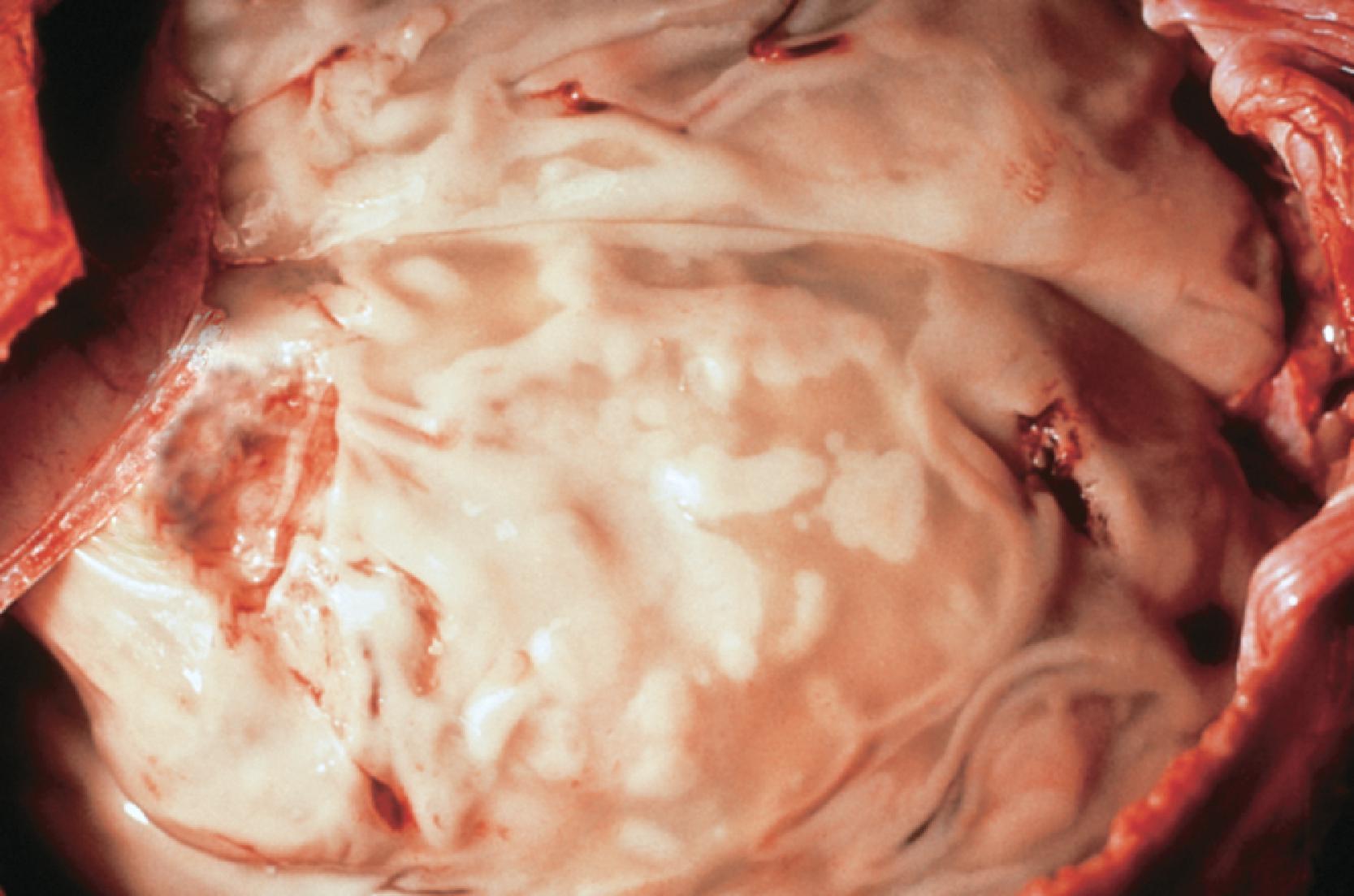
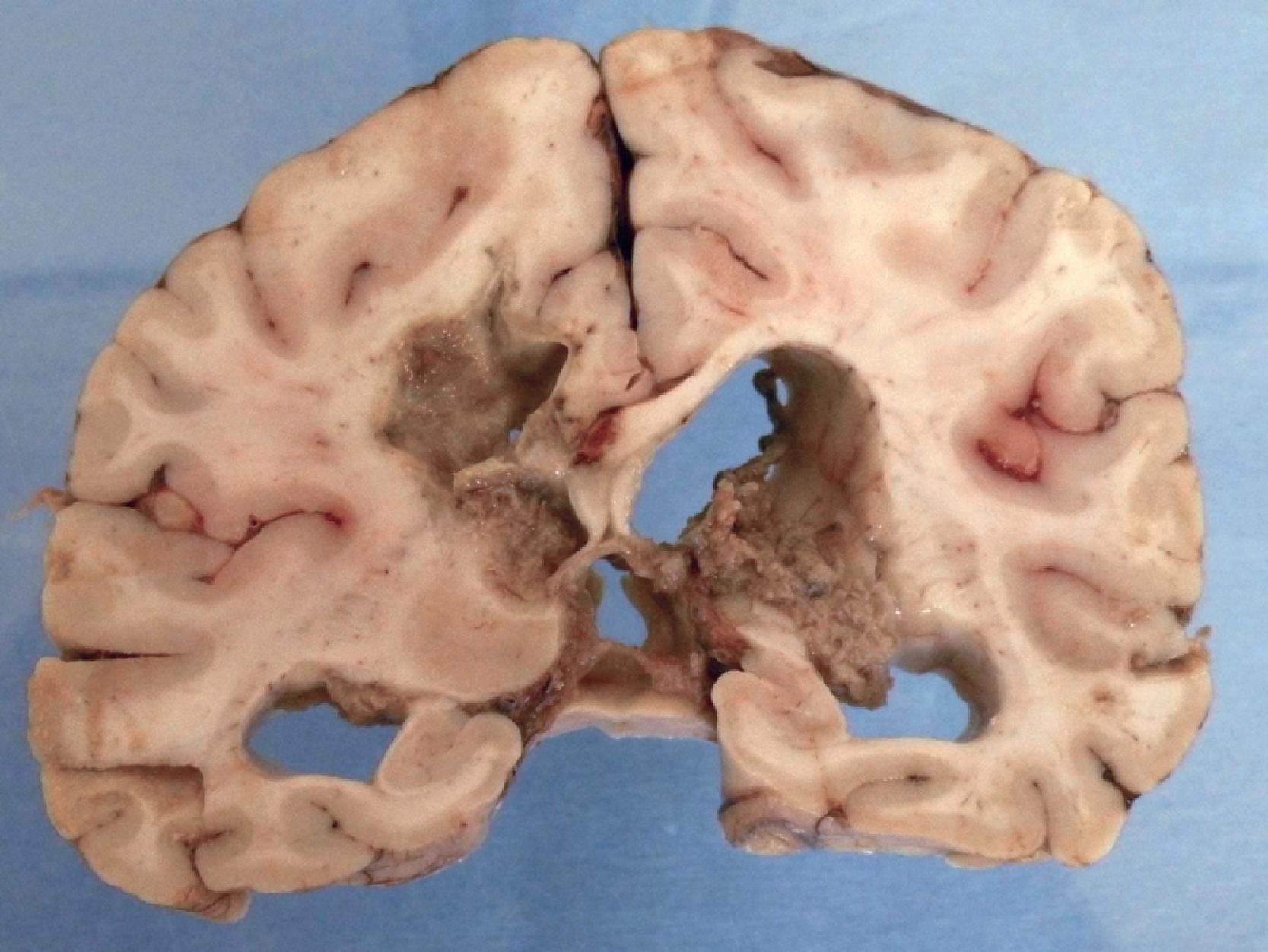
Microscopically, neutrophils fill the subarachnoid space and are characteristically easiest to find around blood vessels ( Fig. 7.3 ). They may infiltrate the walls of leptomeningeal veins and thereby lead to venous occlusion and hemorrhagic infarction of the underlying brain, which is often edematous. Gram stain may reveal the causative organism, although organisms are frequently not demonstrable in treated cases.
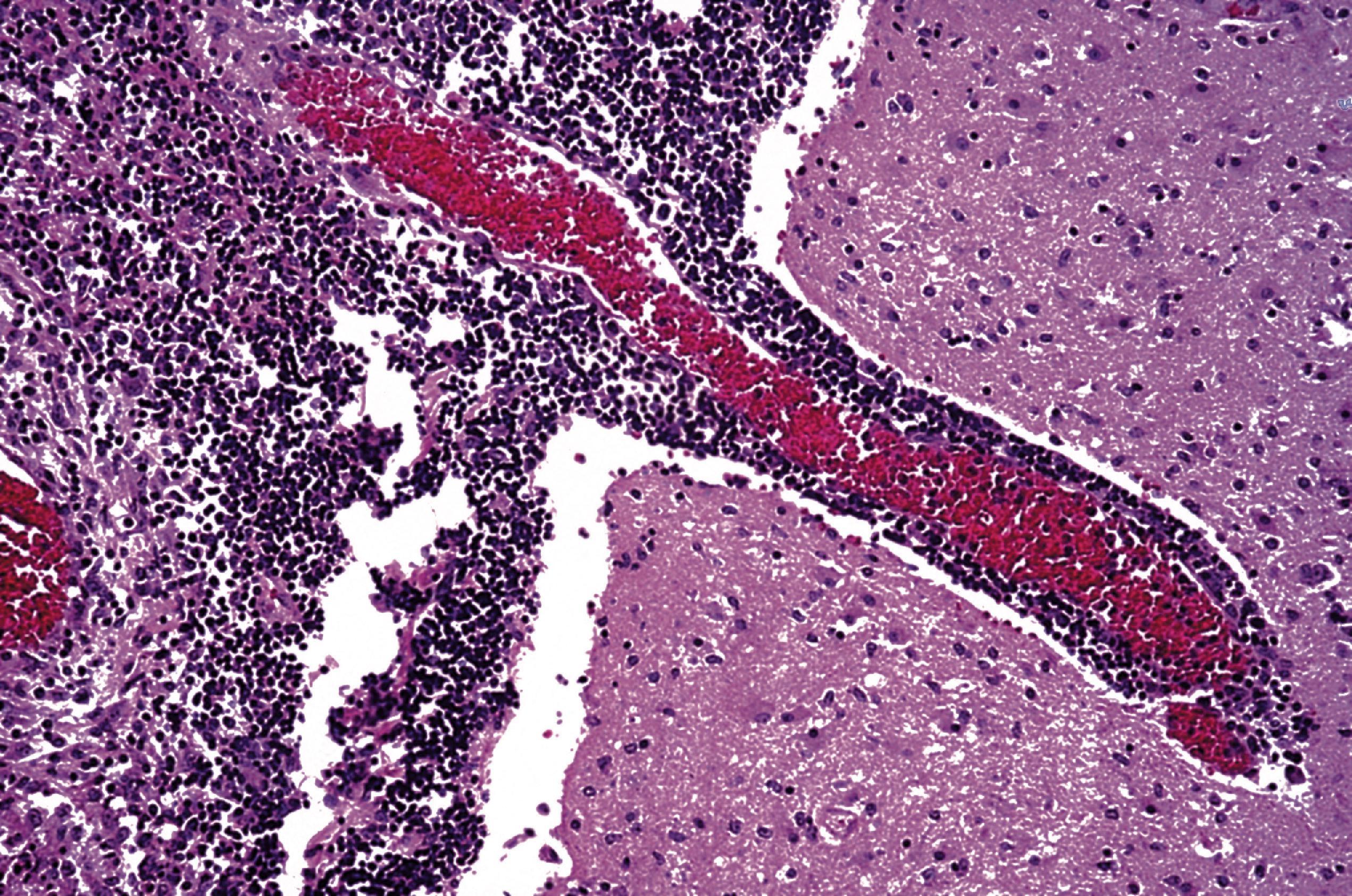
The diagnosis of bacterial meningitis is pathologically straightforward. At autopsy, pus in the leptomeninges should be distinguished from the much more commonly encountered age-related leptomeningeal fibrosis. Fibrosis is typically parasagittal rather than basilar in location, does not follow a vascular distribution, and is not movable within the subarachnoid space.
Untreated bacterial meningitis is uniformly fatal. With treatment, case fatality rates vary with age, causative organism, and income status and range up to 40 %–50 %. Empiric antibiotic therapy should be based on the most common bacterial pathogens that cause disease according to the patient’s age group, clinical setting, epidemiology, and local antibiotic susceptibility patterns. Agents effective against most of the commonly encountered pathogens include ampicillin, broad-spectrum cephalosporins, and vancomycin. The use of adjunctive dexamethasone therapy has led to decreased rates of unfavorable outcomes and death. Vaccination of susceptible individuals is important in the prevention of meningitis.
An abscess is a localized focus of suppurative inflammation. Most cases are bacterial in origin. Brain abscesses arise by contiguous spread from adjacent sites in approximately half of cases. Cases resulting from direct implantation following trauma or a surgical procedure are most commonly caused by skin-colonizing bacteria such as Staphylococcus aureus and Staphylococcus epidermidis or by Gram-negative bacilli. Hematogenous spread to the brain accounts for approximately one-third of cases and is often associated with underlying conditions such as cardiac or pulmonary disease including endocarditis or congenital heart disease; these cases are most commonly caused by staphylococci or streptococci. Polymicrobial infections are common in cases resulting from spread from the paranasal sinuses or from dental infections.
Brain abscesses may occur in any age group. Signs and symptoms in individual patients depend on the location of the lesion but most often include headache, nausea, emesis, alterations in consciousness, seizures, and motor weakness. Fever and evidence of a systemic or local source of infection may or may not be apparent.
The radiographic appearance of brain abscesses is variable and evolves with time. Early cerebritis may be detected as an area of low attenuation on computed tomography (CT) or as an area of high signal intensity on T2-weighted magnetic resonance imaging (MRI). With time, a collagenous capsule that is dense on CT and of low signal on MRI becomes evident and is classically thinnest on the side nearest the lateral ventricle. A well-defined, ring-like pattern of enhancement appears after the administration of contrast material ( Fig. 7.4 ). Lesions are often multiple and are typically located at the gray-white matter junction in the distribution of the middle cerebral artery. Diffusion-weighted imaging (DWI) is the method of choice; almost all pyogenic abscesses show markedly hyperintense and homogeneous signal on DWI.
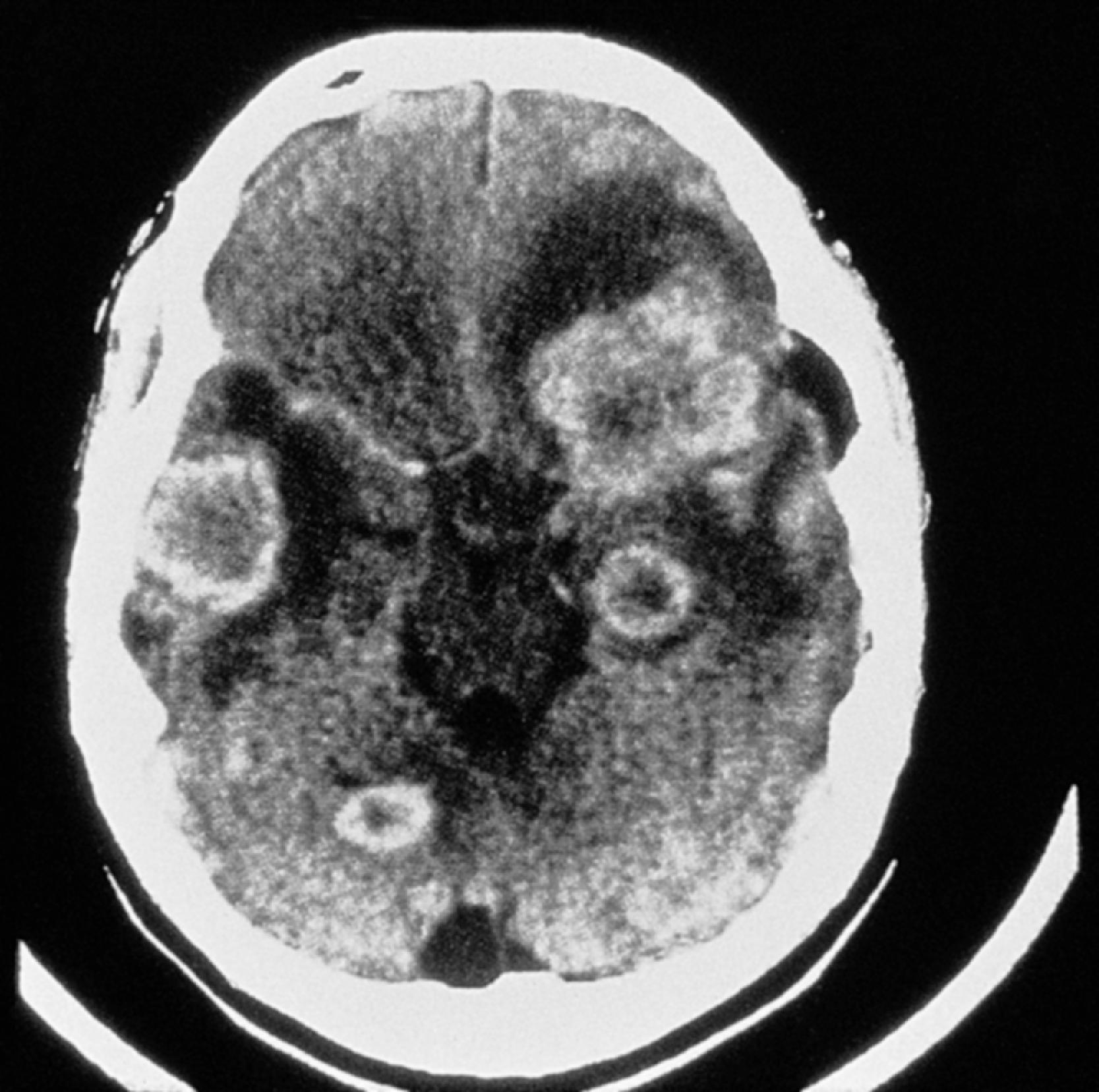
A localized focus of suppurative inflammation
Predisposing conditions: endocarditis, congenital heart disease, chronic pulmonary infection, dental infections
Headache, progressive focal deficits, signs of increased intracranial pressure
Signs of a systemic infection may be present
Fibrous capsule that is thinner nearest the lateral ventricle
Ring enhancing with the administration of contrast material
Hyperintense, homogeneous signal on DWI
Good prognosis if diagnosed in a timely fashion
Treatment includes antibiotics and surgery
Gross Findings
Early abscesses are irregular areas of suppuration. With time, a capsule develops. Encapsulation begins as a rim of granulation tissue that ultimately evolves into a firm, fibrous capsule ( Fig. 7.5 ). Satellite lesions, or “daughter” abscesses, may develop, usually inwardly, and may rupture into the ventricular system.
Microscopic Findings
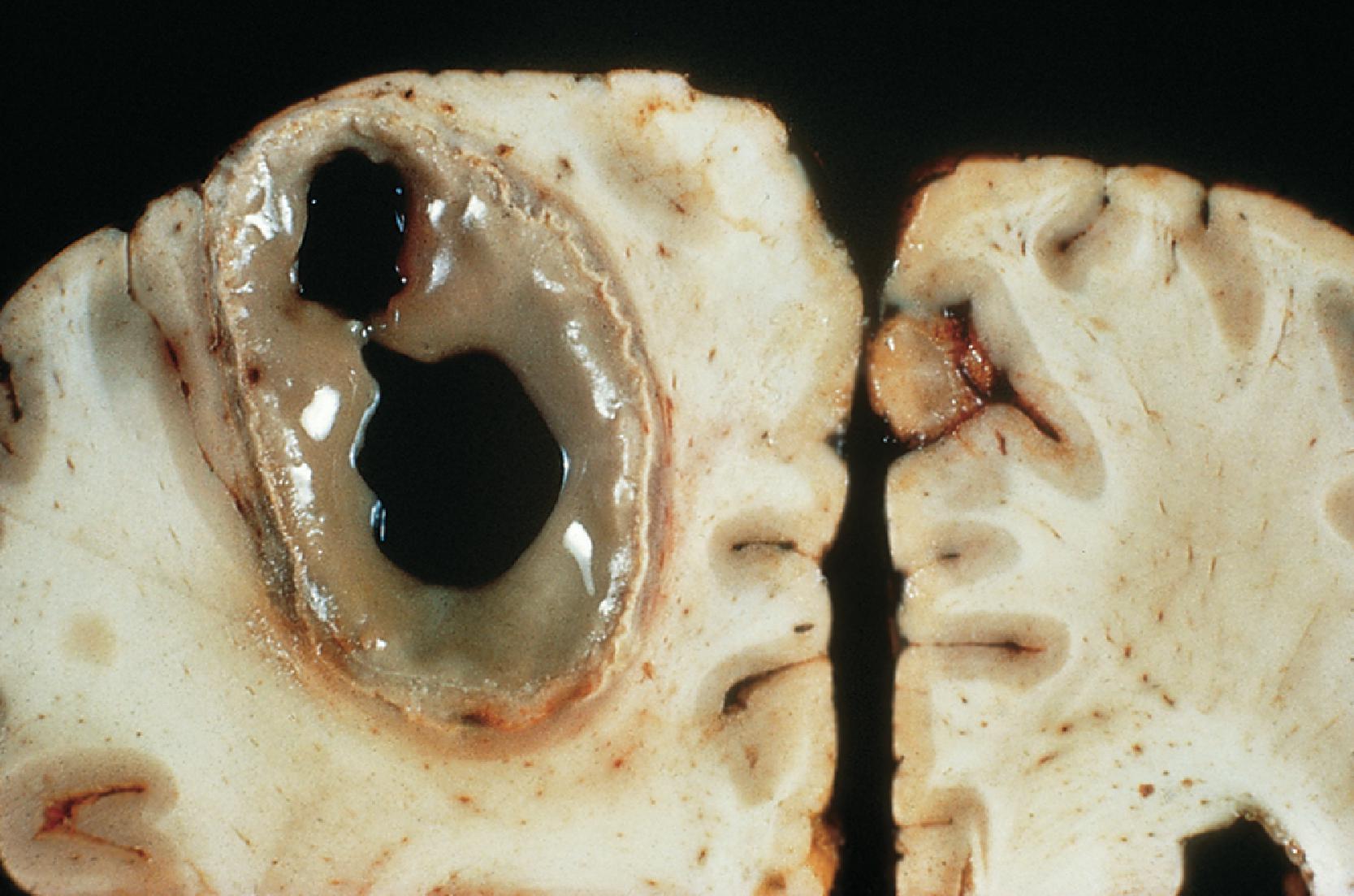
Abscesses begin as foci of cerebritis, characterized by collections of neutrophils associated with necrosis and edema (early stage: days 1 to 3 [ Fig. 7.6A ]). Later, neutrophils are replaced by macrophages and lymphocytes (intermediate stage: days 4 to 9). In the final or capsular stage (day 10 onward), granulation tissue surrounds the area of inflammation ( Fig. 7.6B ) and eventually develops into a fibrous capsule. This capsule in turn is surrounded by gliotic, edematous brain tissue.
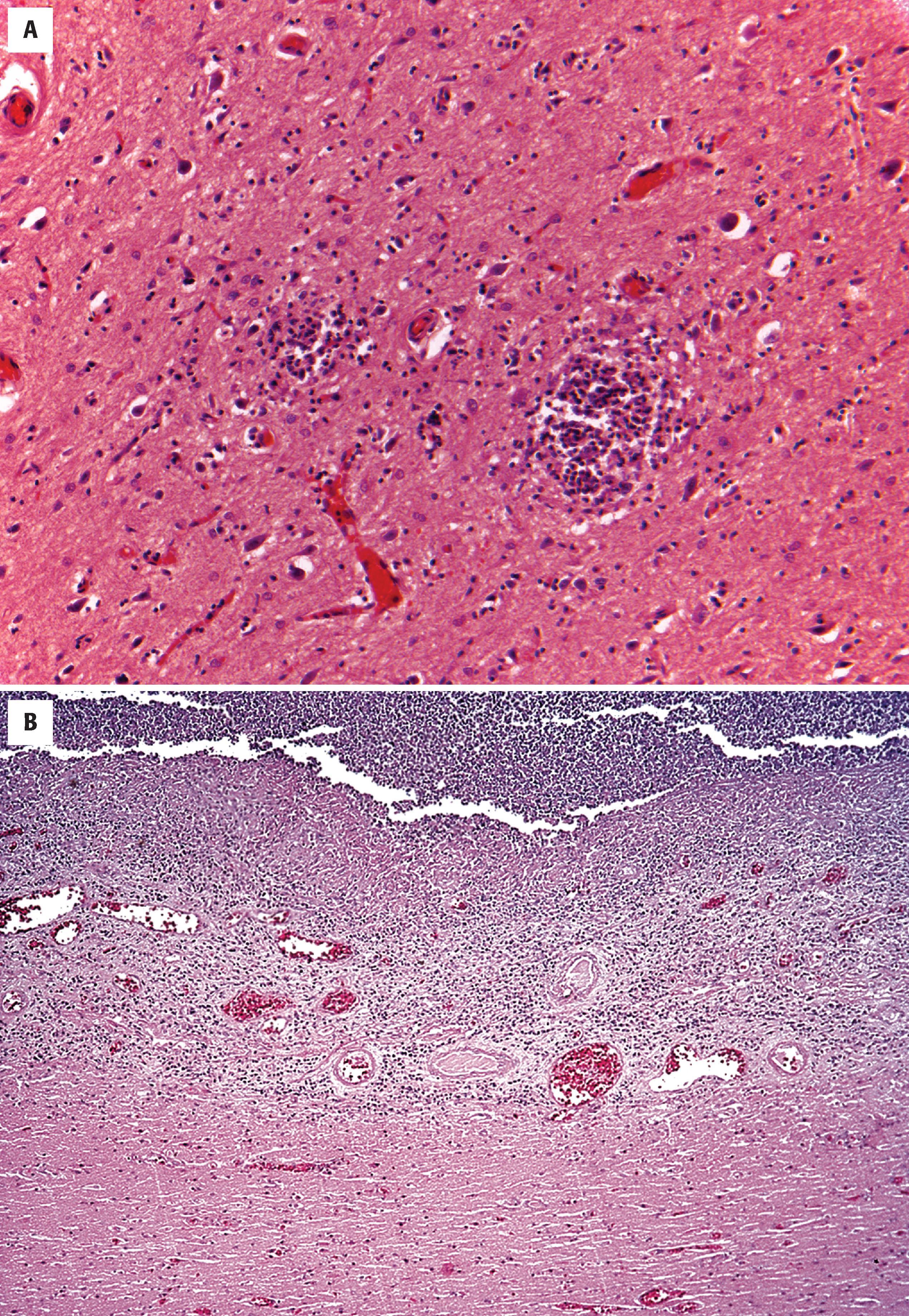
Suppuration surrounded by a fibrous capsule
Satellite lesions
Early stage: cerebritis with collections of neutrophils
Intermediate stage: macrophages and lymphocytes
Capsule stage: necrosis and inflammation surrounded by granulation tissue, a collagenous capsule, and gliosis
High-grade glial neoplasm
Brain abscesses are most often confused with high-grade glial neoplasms both radiographically and pathologically. This error in diagnosis is most common at the time of frozen section, when the pathologist is confronted with a highly cellular lesion containing astrocytic cells in the clinical setting of a ring-enhancing lesion thought to be a tumor by the surgeon. The presence of inflammatory cells, including neutrophils and macrophages, should prompt consideration of a nonneoplastic process inasmuch as primary central nervous system (CNS) tumors rarely contain a significant associated inflammatory infiltrate.
Survival from a brain abscess is the rule in appropriately diagnosed and treated cases; the single most important contributing factor to mortality and permanent neurologic deficit is delay in diagnosis. Most cases are treated with antimicrobial therapy. Surgery to drain or remove the abscess and to identify the causative organism is necessary in some instances. Adjunctive glucocorticoid therapy to reduce cerebral edema and hyperbaric oxygen are used in some cases. Approximately 70 % of patients have minimal or no neurologic sequelae.
Tuberculosis (TB) is the most common mycobacterial infection involving the CNS. TB is caused by Mycobacterium tuberculosis , which is a Gram-positive, acid-fast rod. It remains a major world health problem and is responsible for 1.5–2 million deaths per year worldwide. CNS involvement is secondary to hematogenous dissemination from foci of disease elsewhere in the body, most frequently the lungs. Mycobacteria in the CNS prompt the formation of foci of granulomatous inflammation, which are thought to coalesce into larger tubercles with caseous necrosis, which may rupture into the subarachnoid space (so-called Rich foci). The advent of AIDS has modified the epidemiology of TB; the immunosuppression characteristic of AIDS has increased the number of people susceptible to TB.
Nontuberculous (atypical) mycobacteria may also infect the CNS. These organisms, including those of the M. avium complex, M. kansasii , M. scrofulaceum , M. xenopi , M. genavense , and M. malmoense , typically produce disease in immunocompromised patients, particularly those with AIDS.
Leprosy is due to infection by Mycobacterium leprae . This organism predominantly involves the peripheral nervous system.
Tuberculous meningitis is the most common form of tuberculosis of the CNS in the United States and other developed countries. It manifests as generalized complaints of headache, malaise, mental confusion, and vomiting. CSF findings include increased pressure, a pleocytosis made up of mononuclear cells or a combination of polymorphonuclear and mononuclear cells, moderately elevated protein levels, and a reduced or normal glucose content. There is often a history of or a concurrent positive tuberculin skin test or a history of exposure to TB. Active pulmonary TB is present on chest radiographs in 30 % to 50 % of cases.
Tuberculomas produce signs and symptoms of a mass. These lesions, which remain a common cause of intracranial masses in tropical countries, occur most often in the first three decades of life. There is often a history of exposure to the organism or recognized extracranial disease. The most common signs and symptoms include headache, seizures, papilledema, hemiplegia, and cerebellar dysfunction.
Spinal tuberculosis can result from foci of spinal cord myelitis/arachnoiditis or from vertebral body involvement (Pott disease). Patients typically present with some combination of signs of nerve root and cord compression.
Patients with tuberculosis and human immunodeficiency virus (HIV) infection may develop immune reconstitution inflammatory syndrome (see below).
Nontuberculous mycobacteria most commonly cause disseminated disease in immunocompromised individuals. The CNS may be affected, but this involvement is usually asymptomatic. When symptomatic CNS involvement does occur, the signs and symptoms are nonspecific and include a diffuse encephalopathy, seizures, headache, altered mentation or impaired cognition, nuchal rigidity, lethargy, cranial nerve palsies, and progressive neurologic deterioration.
Infections caused by M. tuberculosis or one of a variety of nontuberculous mycobacteria
Occurs worldwide
Increased incidence in immunocompromised individuals
TB meningitis: headache, malaise, mental confusion, and vomiting
Tuberculoma: symptoms of a mass lesion
CSF findings: increased pressure, a pleocytosis made up of mononuclear cells, elevated protein levels, and reduced or normal glucose content
Nontuberculous mycobacteria: asymptomatic or nonspecific symptoms
Enhancement at the base of the brain and hydrocephalus in TB meningitis
Multilocular lesion with a peripheral rim of contrast enhancement and a hypodense, necrotic center (tuberculoma)
Mycobacterial pseudotumor: hyperdense lesion with surrounding edema
Often fatal without early treatment
Combination of antimycobacterial agents and corticosteroid therapy
Prophylactic therapy in asymptomatic patients
Bacille Calmette-Guérin (BCG) vaccine
In tuberculous meningitis, there may be radiologic enhancement at the base of the brain. Hydrocephalus is present in approximately 75 % of cases. A tuberculoma is a single or multilocular lesion with a peripheral rim of contrast enhancement and a hypodense, necrotic center. Spindle cell pseudotumors may rarely be seen in those with infections caused by atypical mycobacteria; these lesions produce hyperdense masses with surrounding edema on imaging studies.
Tuberculous meningitis is characterized by a thick, gray exudate that typically involves the base of the brain but subsequently extends to the Sylvian fissures and envelopes the spinal cord ( Fig. 7.7A ). Small nodules or tubercles may be identified in this exudate.

Tuberculomas are round or oval masses. They have necrotic, firm centers and are creamy in color ( Fig. 7.7B ). The surrounding rim is gray and gelatinous, and there is much less swelling than around cerebral abscesses.
TB meningitis: thick, gray exudate that typically involves the base of the brain
Tuberculoma: round or oval mass with a necrotic, firm center; creamy in color
TB meningitis: lymphocytes, plasma cells, and tubercles with necrotic centers surrounded by epithelioid histiocytes and lymphocytes; obliterative endarteritis
Tuberculoma: necrotizing granulomatous inflammation surrounded by gliotic brain tissue
Acid-fast organisms difficult to identify
Nontuberculous mycobacteria: poorly formed granulomas, perivascular lymphocytes and macrophages with acid-fast organisms, spindle cell pseudotumors
PCR to identify mycobacterial DNA
Fungal infections
Sarcoidosis
In TB meningitis, one sees lymphocytes, other mononuclear inflammatory cells, and tubercles/granulomas composed of a central area of necrosis surrounded by epithelioid cells and lymphocytes. Langhans giant cells may also be seen but are typically sparse. Meningeal blood vessels may be involved with resulting fibrinoid necrosis and thrombosis. So-called endarteritis obliterans, characterized by thickening of the vascular intima by collagenous fibrosis, may be present. The diagnosis is definitively established by identifying acid-fast organisms with either a Ziehl-Neelsen stain ( Fig. 7.8 ) or an auramine-rhodamine fluorescent technique. Organisms are often difficult to identify, especially if treatment has been initiated; therefore a negative acid-fast stain does not completely exclude the diagnosis.
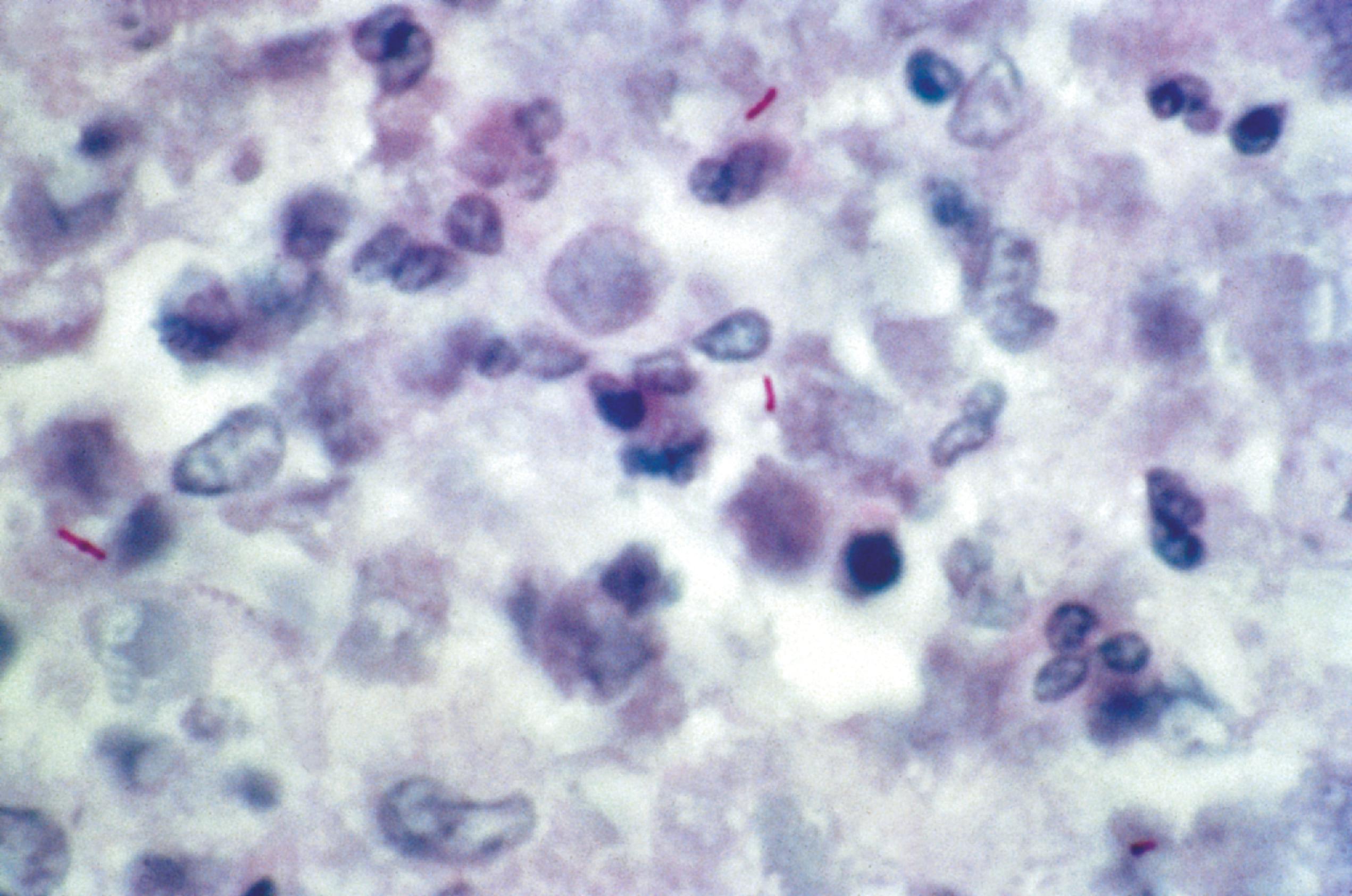
Tuberculomas are also characterized by necrotizing granulomatous inflammation. Typically, they consist of a caseous center surrounded by epithelioid histiocytes, giant cells, and lymphocytes ( Fig. 7.9 ). The surrounding brain tissue is gliotic. Again, organisms may be difficult to identify.
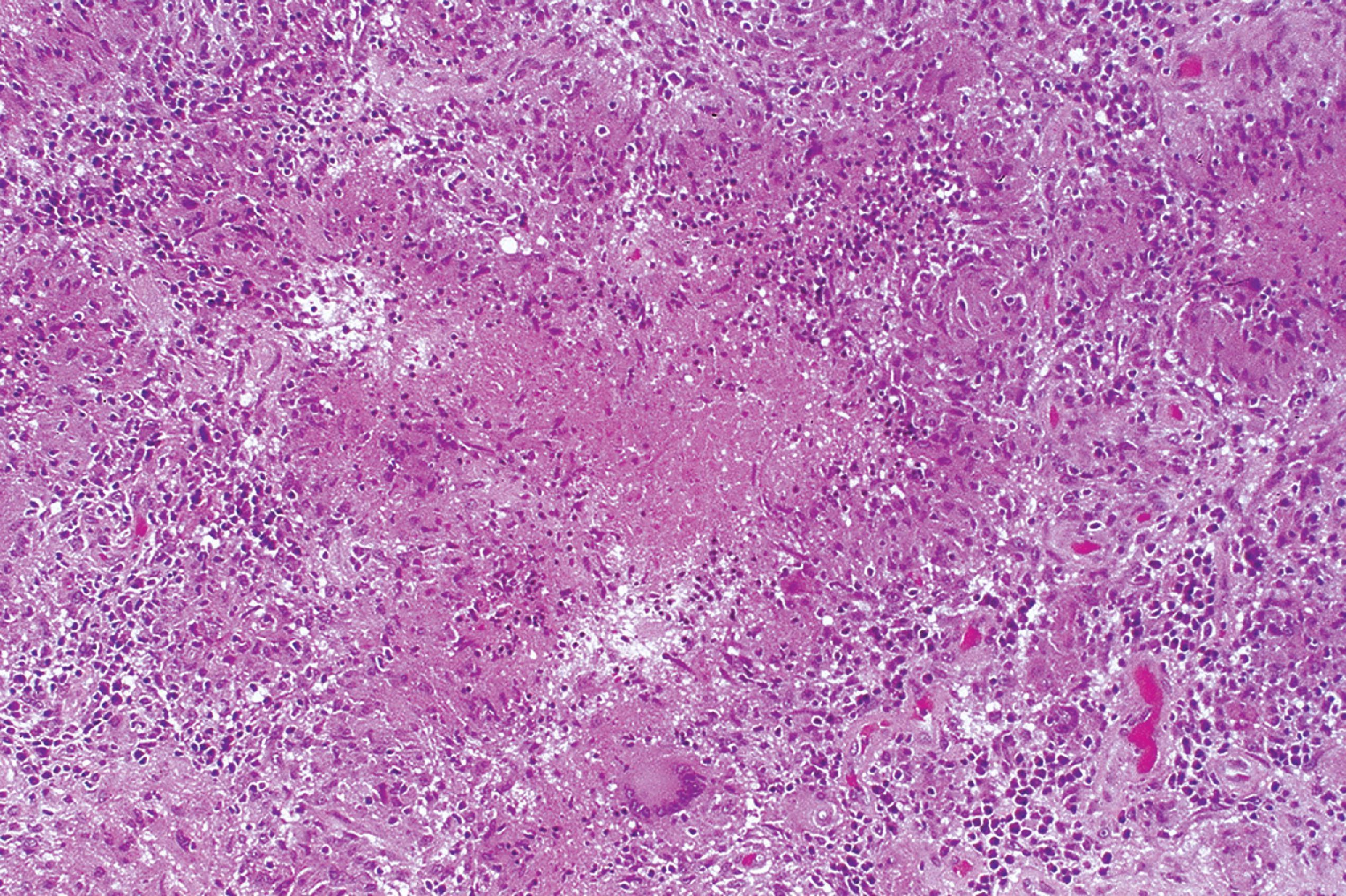
Nontuberculous mycobacteria may also produce granulomatous inflammation, but the granulomas are typically poorly formed. Perivascular infiltrates composed of lymphocytes and macrophages, some of which contain acid-fast organisms ( Fig. 7.10 ), may be seen in symptomatic patients. Rarely, spindle cell pseudotumors, which are identical to those seen in other organ systems in immunocompromised patients, may be present. They are composed of spindle cells arranged in fascicles associated with lymphocytes, plasma cells, and occasional neutrophils. Acid-fast bacilli may be seen within the spindle cells.
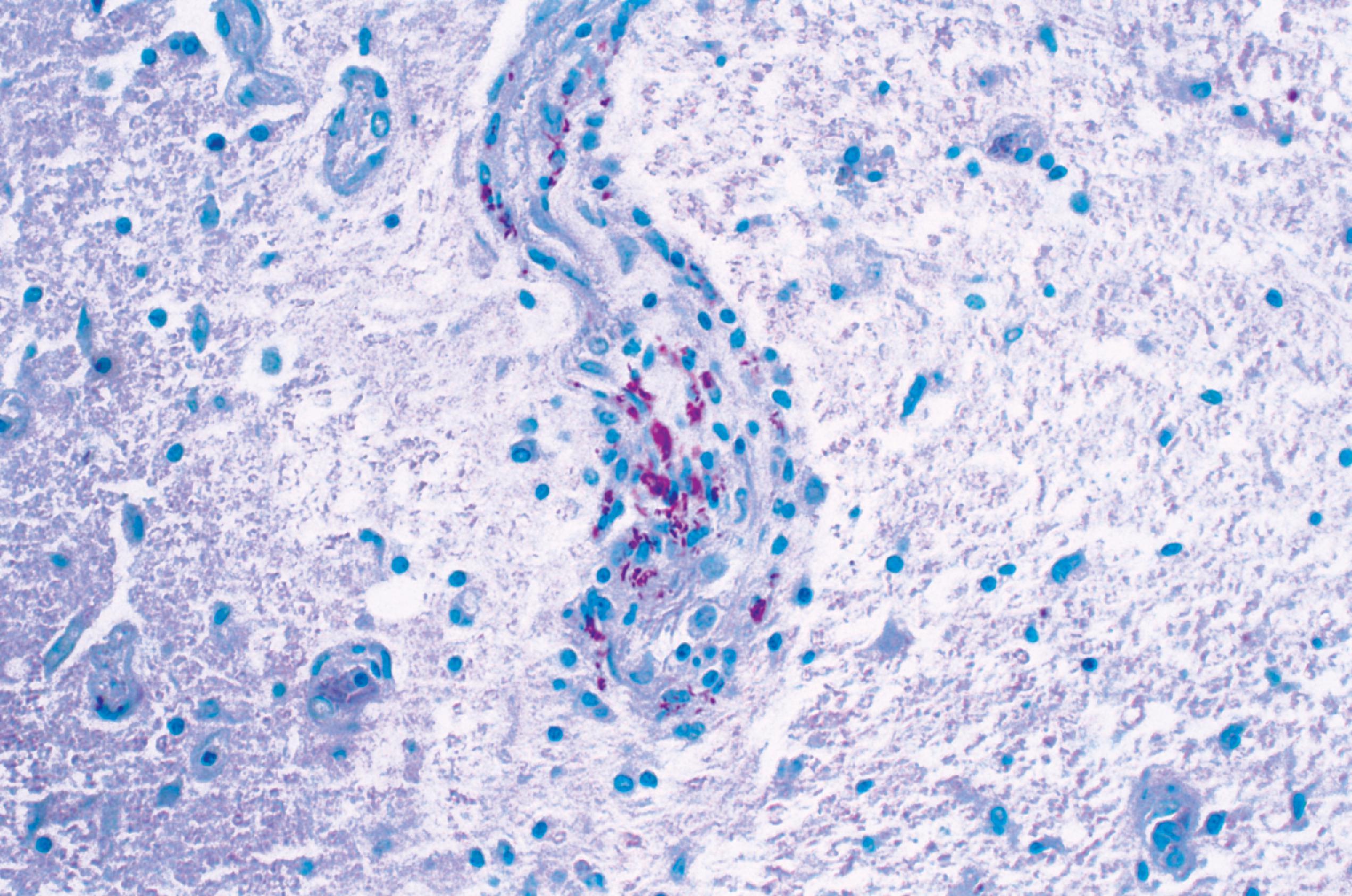
Detection of mycobacterial DNA sequences with PCR is a useful diagnostic procedure when organisms cannot be identified by conventional means.
Necrotizing granulomatous inflammation is characteristic of TB. However, other infectious processes, particularly those caused by fungi, can produce a similar pattern of inflammation and need to be considered in the differential diagnosis. A combination of acid-fast and methenamine silver stain or periodic acid–Schiff (PAS) stain is useful in establishing a diagnosis when granulomas are encountered. The granulomas of sarcoidosis are typically nonnecrotizing; however, necrosis can occur in this disorder. The diagnosis of sarcoidosis is one of exclusion and should be considered only after infectious causes have been ruled out.
Disseminated TB is often fatal unless treated early. A combination of antimycobacterial agents, including isoniazid, rifampin, pyrazinamide, and ethambutol, is used to minimize the possibility of antibiotic resistance, which has become an increasingly common problem. Adjunctive corticosteroid therapy is recommended for all patients with CNS disease. Prophylactic treatment of those infected with M. tuberculosis but free of disease is useful in preventing CNS disease. An attenuated vaccine developed from a strain of M. bovis by Calmette and Guérin (the BCG vaccine) is used in some groups but may cause infection, particularly in immunosuppressed patients.
Syphilis is caused by the spirochete Treponema pallidum . This organism is transmitted in adults by venereal contact or in children transplacentally from mother to fetus. Neurosyphilis occurs predominantly in patients with tertiary syphilis, although meningitis or cranial nerve palsies can occur during the acute disseminated phase of infection (early neurosyphilis).
Although rare, there has been a resurgence of syphilis in low- and middle-income countries and in certain populations, including those with HIV coinfection, in developed countries. In patients in whom tertiary syphilis develops, asymptomatic neurosyphilis is common. The clinical findings in symptomatic patients are extremely variable, and neurosyphilis has been termed “the great imitator” of other diseases because the clinical presentation is often atypical and misleading. Those with HIV infection are more likely to progress to symptomatic neurosyphilis and to have an accelerated course. Ocular manifestations may also be more common in this patient population.
Patients with meningovascular neurosyphilis present with signs of chronic meningitis. If the vascular component of the disease is severe, infarcts may develop. Extension of the inflammatory process into cranial and spinal nerves and blood vessels may produce optic atrophy or cranial nerve palsies. If the meningeal exudate organizes, symptoms of obstructive hydrocephalus may develop.
Paretic neurosyphilis occurs when brain tissue is invaded by the treponemal organisms. In this form of the disease, which has been termed “general paresis of the insane,” an insidious, progressive loss of mental and physical functions develops, with mood alterations terminating in severe dementia. Argyll Robertson pupils, which show accommodation but do not react to light, are seen in this form of tertiary neurosyphilis.
Tabes dorsalis results from damage to the sensory nerves in the dorsal roots of the spinal cord. Sensory disturbances, including “lightning pains” and loss of deep tendon reflexes, are typical findings. Impaired joint position sense with ataxia and loss of pain sensation leading to skin and joint damage (Charcot joints) are also observed.
The diagnosis of neurosyphilis is based on serum and CSF serologic tests. These are classified as non-treponemal (Venereal Disease Research Laboratory [VDRL] or rapid plasma reagin) or treponemal (fluorescent treponemal-antibody absorption [FTA-ABS]) tests. The sensitivity and specificity of these tests are variable and depend on the choice of control material, the prevalence and stage of syphilis, and the accuracy of the diagnoses used for reference. The diagnosis of symptomatic neurosyphilis may be made if a serum FTA-ABS test is reactive (reflecting previous syphilis) and a CSF VDRL test is reactive (indicating neurosyphilis). Testing for HIV infection is recommended in all patients with syphilis. Serial examination of the CSF white cell count is often used to determine the adequacy of treatment. Stigmata of congenital syphilis include interstitial keratitis, chorioretinitis, and deafness. In congenitally infected children, all the aforementioned neurosyphilitic syndromes may eventually develop.
An infection caused by the spirochete T. pallidum ; neurosyphilis usually occurs as part of tertiary syphilis
Increasing incidence in developing countries and in those with HIV coinfection
Often asymptomatic
Meningovascular neurosyphilis: chronic meningitis and infarcts
Paretic neurosyphilis: insidious, progressive dementia; Argyll Robertson pupils
Tabes dorsalis: “lightning pains,” loss of reflexes, loss of joint position sense with ataxia, loss of pain sensation, Charcot joints
Congenital syphilis: interstitial keratitis, chorioretinitis, and deafness
Reactive serum FTA-ABS and CSF VDRL tests confirm the diagnosis
Largely preventive
Penicillin in undetected cases
Thickened, fibrotic meninges are characteristic of meningovascular neurosyphilis. When the infection is confined to the cervical region, the term “pachymeningitis cervicalis hypertrophica” has been applied. Syphilitic gummas, which vary from 0.1 to 4 cm in diameter, may occur in the meninges, where they are usually attached to the dura and the underlying brain, in which they become embedded. Gummas are generally round, reddish tan to gray, and firm and rubbery with a central area of necrosis.
The brains of patients suffering from paretic neurosyphilis are shrunken and firm and covered by thick, opaque leptomeninges. The atrophy is most marked frontally ( Fig. 7.11 ), and the ventricles are typically greatly enlarged. The ependyma may have a fine ground-glass appearance because of extensive granular ependymitis.
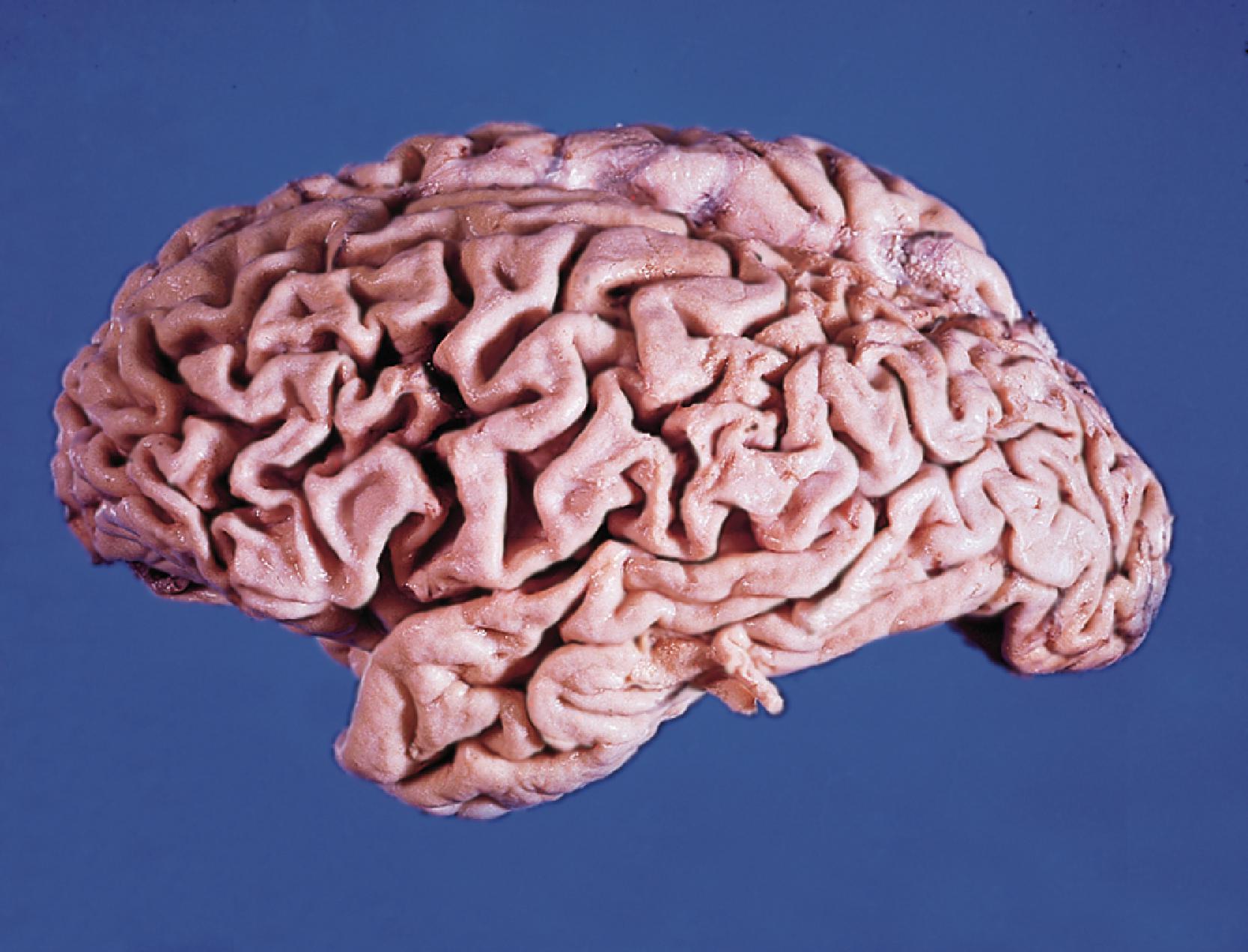
In long-standing tabes dorsalis, degeneration of the posterior columns leads to an excavated dorsal surface of the spinal cord. The posterior nerve roots are gray and shrunken.
In meningovascular neurosyphilis, an admixture of lymphocytes and plasma cells is present in association with fibrosis. The vascular component, termed “Heubner arteritis,” is a form of endarteritis obliterans with crescentic, collagenous thickening of the vascular intima. Lymphocytes and plasma cells are present in the adventitia, cuffing the vasa vasorum, and may penetrate the media. Gummas, if present, consist of a central area of necrosis surrounded by epithelioid histiocytes, multinucleated foreign body-type giant cells, lymphocytes, plasma cells, and focal fibrosis.
The cerebral cortex in paretic neurosyphilis is atrophic and lacks a normal laminar architectural pattern. There is loss of neurons with proliferation of astrocytes and microglial cells. The microglial cells are hypertrophied and elongated and often contain abundant iron, which may be highlighted with a Perls stain. The cerebral cortex has been described as having a windswept or bush fire appearance. There may be perivascular lymphocytes and plasma cells, and treponemal organisms may occasionally be observed with special stains (modified Steiner or Warthin-Starry silver stains).
Tabes dorsalis is characterized by a loss of myelinated axons in the dorsal nerve roots and pallor and atrophy in the dorsal columns ( Fig. 7.12 ). Typically, no significant inflammatory infiltrate is found, and organisms are not identifiable.
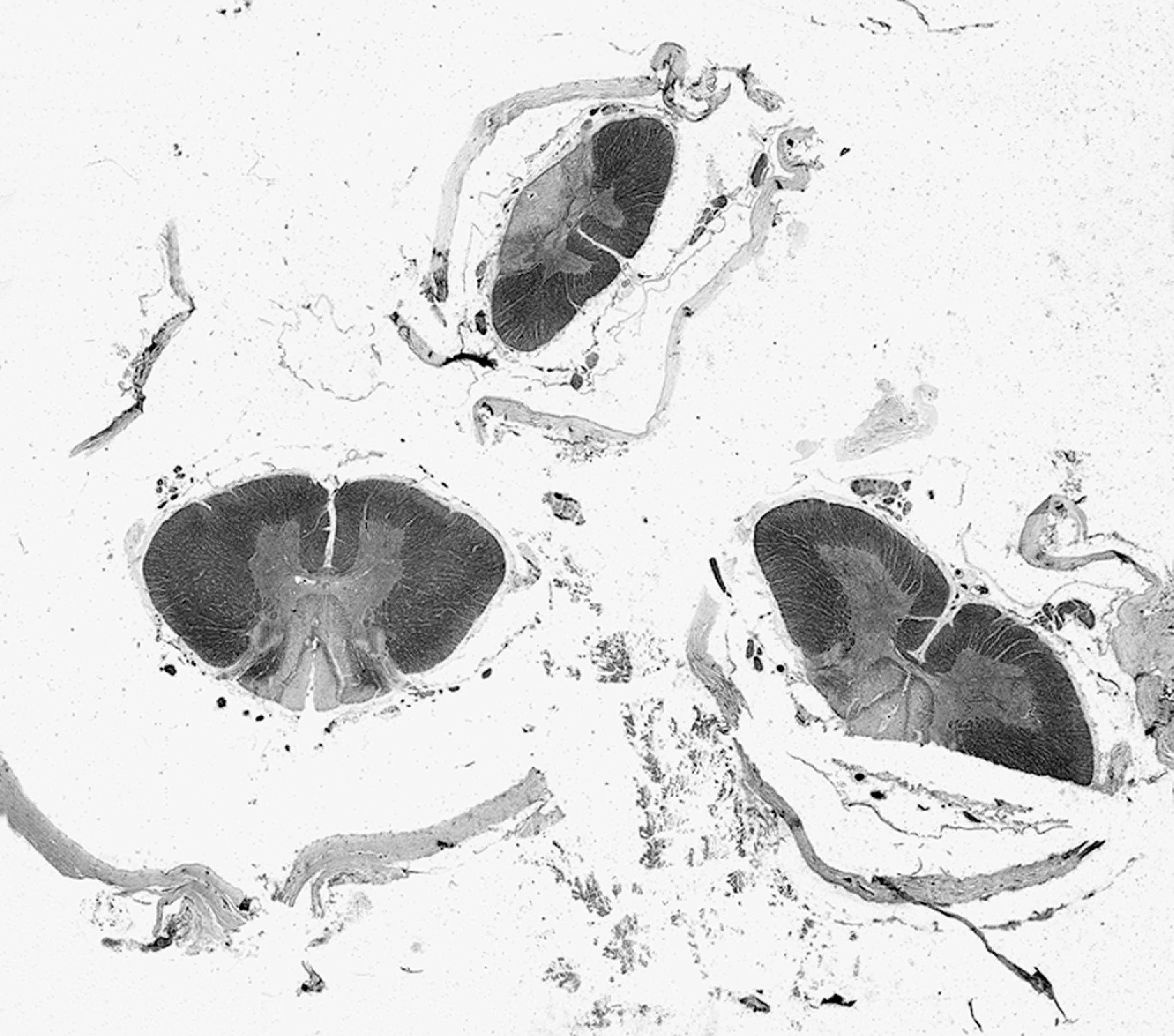
Meningovascular neurosyphilis: thick, opaque meninges and gummas
Paretic neurosyphilis: atrophy, meningeal fibrosis, large ventricles, granular ependymitis
Tabes dorsalis: excavated dorsal spinal cord, atrophic and gray dorsal nerve roots
Meningovascular neurosyphilis: lymphocytes and plasma cells, obliterative endarteritis, necrotizing granulomatous inflammation in gummas
Paretic neurosyphilis: loss of cerebral laminar architecture with neuronal loss and proliferation of astrocytes and microglial cells; organisms may be identified
Tabes dorsalis: loss of myelinated axons in nerve roots with pallor and atrophy of the dorsal columns; no organisms
Tuberculosis and other causes of granulomatous inflammation
Tabes dorsalis: subacute, combined degeneration, vacuolar myelopathy, tropical spastic paraparesis
The obliterative endarteritis seen in meningovascular syphilis is similar to and should be distinguished from that seen in tuberculosis. Similarly, syphilitic gummas must be distinguished from other forms of granulomatous inflammation. The differential diagnosis of tabes dorsalis includes subacute combined degeneration of the spinal cord as a result of vitamin B12 deficiency, the vacuolar myelopathy of AIDS, and tropical spastic paraparesis.
Treatment of neurosyphilis is largely preventive; the disease should be treated in its primary stage. Undetected cases often respond to parenteral penicillin.
Lyme disease is a multisystem infectious disease caused by the tick-borne spirochete Borrelia burgdorferi . It occurs primarily in certain areas of North America, Europe, and Asia, locations reflecting the distribution of Ixodes ticks, which are required for disease transmission. Involvement of the central and peripheral nervous systems is a common manifestation of this disease.
The most common manifestation of Lyme disease is the characteristic cutaneous lesion known as erythema migrans, which typically arises at the site of the tick bite. This is often followed by arthritis affecting large joints. Nervous system manifestations include lymphocytic meningitis, cranial neuropathy, or radiculoneuropathy. In many cases facial nerve palsy is present. Clinical symptoms of meningitis are highly variable and may be indistinguishable from viral meningitis. So-called Lyme encephalopathy, characterized by mild memory and cognitive impairment, is thought to be a nonspecific correlate of chronic inflammation. The CSF typically shows a lymphocytic pleocytosis and protein elevation with increased CSF-to-serum antibody ratios.
A multisystem disease caused by the spirochete B. burgdorferi
Parts of North America, Europe, and Asia
Extraneurologic disease: erythema migrans and large-joint arthritis
Nervous system manifestations: lymphocytic meningitis, cranial neuropathy, and radiculoneuropathy
Treated successfully with doxycycline
Only a few documented reports of the pathologic findings in Lyme disease of the CNS have been published. These reports have demonstrated perivascular inflammation or vasculitis and multifocal areas of demyelination involving the periventricular white matter. Biopsies from tumefactive lesions show gliosis with spirochetal organisms without a significant inflammatory infiltrate.
Perivascular inflammation or vasculitis
Periventricular demyelination
Tumefactive lesions: gliosis with spirochetal organisms and little inflammation
Oral treatment with doxycycline is effective in the majority of patients.
Whipple disease is a rare multisystem disorder caused by Tropheryma whipplei , a Gram-positive actinomycete. Despite the ubiquitous presence of the organism, the disease is extremely rare. It is thought that a defect in cellular immune response may predispose patients to infection.
Whipple disease is typically systemic in nature, although isolated CNS involvement has been reported. Males are affected much more frequently than females, and most cases occur between the fourth and seventh decades of life. Common symptoms include arthralgias, weight loss, steatorrhea, lymphadenopathy, and hyperpigmentation. Cardiac involvement results in a clinical picture of endocarditis and heart failure. CNS manifestations occur in about 15 % of patients and include confusion, memory loss, focal cranial nerve signs, nystagmus, and ophthalmoplegia. Focal enhancing and nonenhancing lesions may be present radiologically. Laboratory findings include those associated with protein losing enteropathy. PCR gene amplification can be used to detect T. whipplei in CSF.
A rare systemic disease caused by T. whipplei
Much more common in males
Fourth through seventh decades
Systemic findings: arthralgias, weight loss, steatorrhea, lymphadenopathy, and hyperpigmentation
CNS findings: confusion, memory loss, focal cranial nerve signs, nystagmus, and ophthalmoplegia
Multiple focal lesions
Fatal if untreated
Responds dramatically to antibiotic therapy
Histologic findings include small collections of macrophages that are often perivascular in location ( Fig. 7.13 ). A lymphoplasmacytic infiltrate and gliosis are also present. The macrophages are lipid laden and filled with sickle-shaped organisms that are PAS-, Gram-, and methenamine silver–positive.
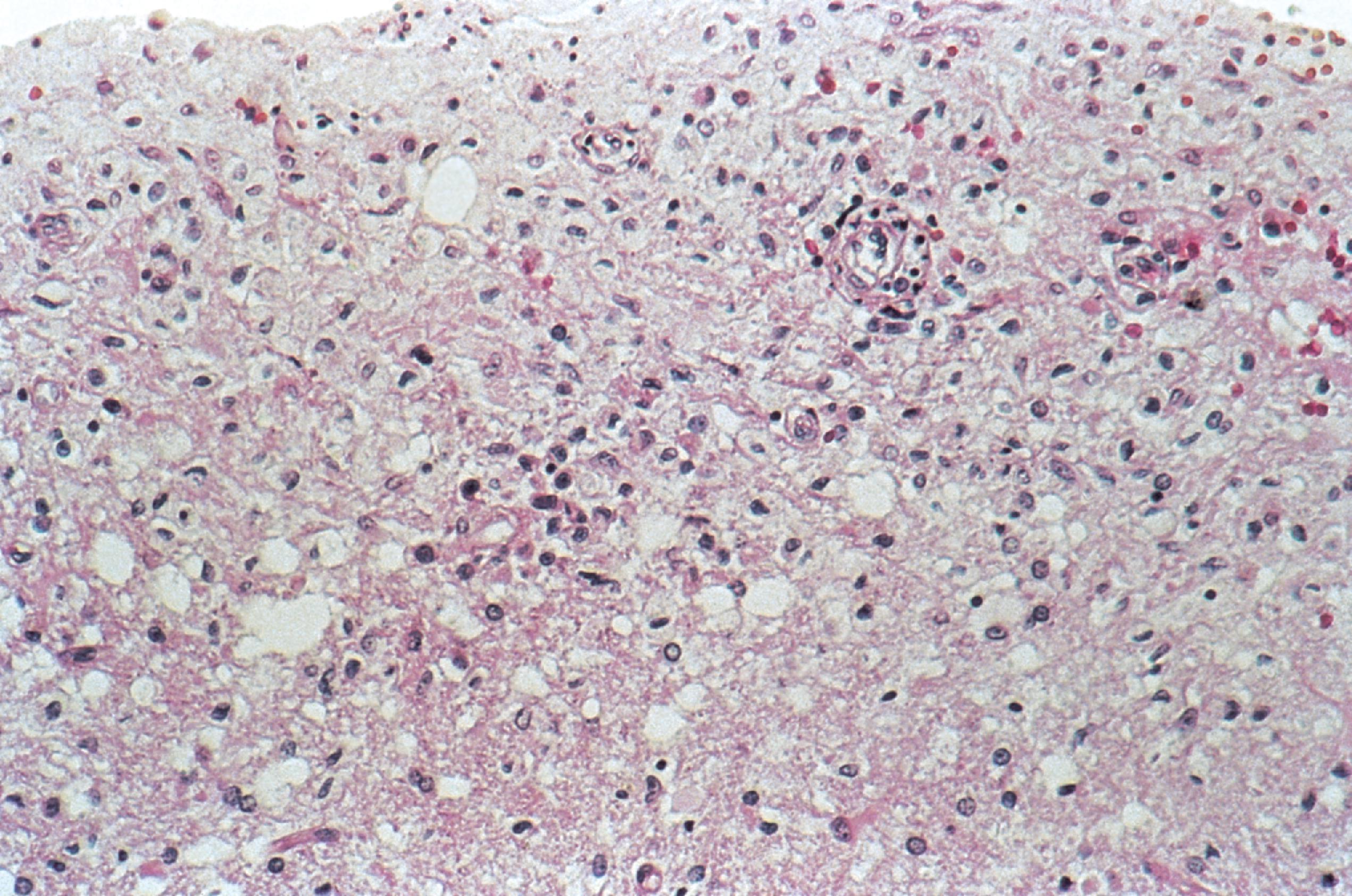
The diagnosis of Whipple disease is not usually difficult if the entity is considered. The differential diagnosis includes infection with organisms of the M. avium complex, which are also present within macrophages in a perivascular location and are PAS- and Gram-positive.
Untreated cerebral Whipple disease may progress to death in 6 to 12 months. However, this infection responds dramatically to appropriate antibiotic therapy, thus highlighting the need for accurate diagnosis.
Actinomyces species are rare but treatable causes of CNS infection. They are anaerobic, Gram-positive, filamentous organisms that are part of the endogenous flora of mucous membranes and colonize the oral cavity, gastrointestinal tract, and vagina. They become pathogenic if the integrity of these mucosal barriers is compromised.
CNS involvement occurs in less than 5 % of Actinomyces infections. Intracranial infections occur after direct trauma, cervicofacial actinomycosis, or hematogenous spread from a systemic infection or as the result of local spread from an ear-nose-throat infection. Risk factors include chronic sinusitis/mastoiditis/gingivitis and dental procedures, congenital heart disease, infected intrauterine devices, and alcoholism. Patients have symptoms of either a space-occupying lesion (abscess) or meningitis.
Actinomycosis of the CNS typically results in abscess formation. The lesions show central necrosis with an inflammatory infiltrate composed predominantly of neutrophils. Colonies of branching organisms form the characteristic sulfur granules ( Fig. 7.14 ). These granules in turn are surrounded by chronic inflammation and granulation tissue. The filamentous organisms are Gram-positive and can be highlighted with methenamine silver stains. 16S rRNA sequencing/next-generation sequencing in addition to culture of abscess material may be more sensitive in identifying the causative organism than culture alone.
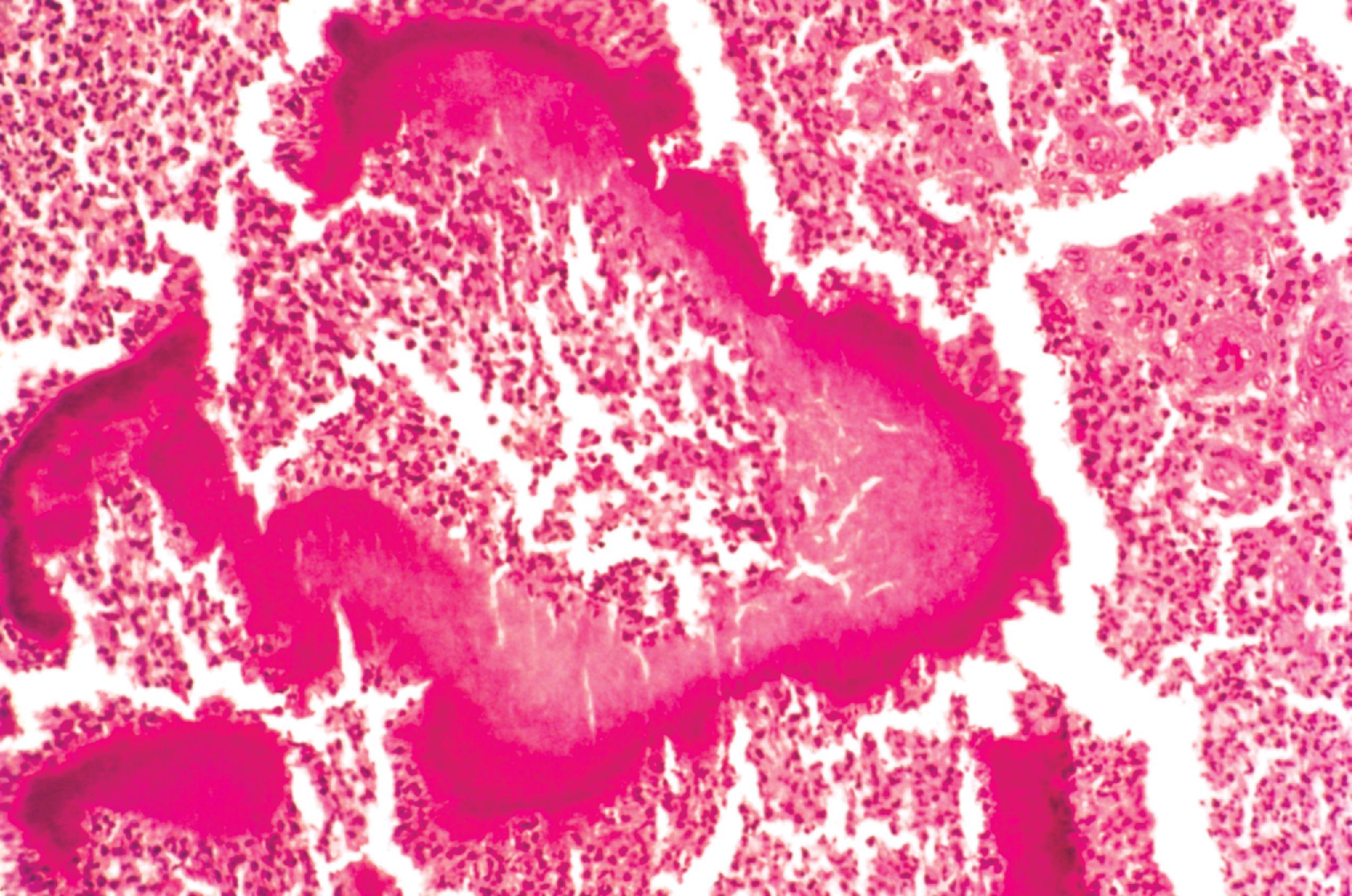
The branching organisms should be distinguished from Nocardia species. The latter organisms are acid-fast.
Optimal management consists of combined adequate surgical drainage and prolonged antibiotic therapy.
Involvement of the CNS is a well-described complication of nocardial infection; CNS disease accounts for approximately 5 % to 35 % of reported nocardial infections. Most cases are caused by Nocardia asteroides or N. farcinica , Gram-positive, acid-fast, aerobic, and filamentous bacteria.
Disease of the CNS caused by Nocardia is generally thought to occur via hematogenous dissemination from an infection in the lungs. Predisposing factors include deficiencies in cell-mediated immunity such as corticosteroid use, organ transplantation, and underlying autoimmune disease. Patients typically present with a subacute onset of signs and symptoms, including head or neck pain, nausea and vomiting, or altered mental status. CSF findings include a neutrophilic pleocytosis with decreased glucose levels.
An infection caused by Nocardia species, usually N. asteroides
Occurs most commonly in immunosuppressed individuals, especially organ transplant patients
Symptoms are subacute and nonspecific
Significant mortality
Sulfonamides are the drugs of choice
Nocardia may produce either abscesses ( Fig. 7.15 ), meningitis, or both. The abscesses are typically similar to those found in other bacterial infections, although a granulomatous reaction can sometimes be seen. The organisms appear as thin, branching filaments and may be identified with a tissue Gram stain, silver stains, or modified acid-fast stains ( Fig. 7.16 ).
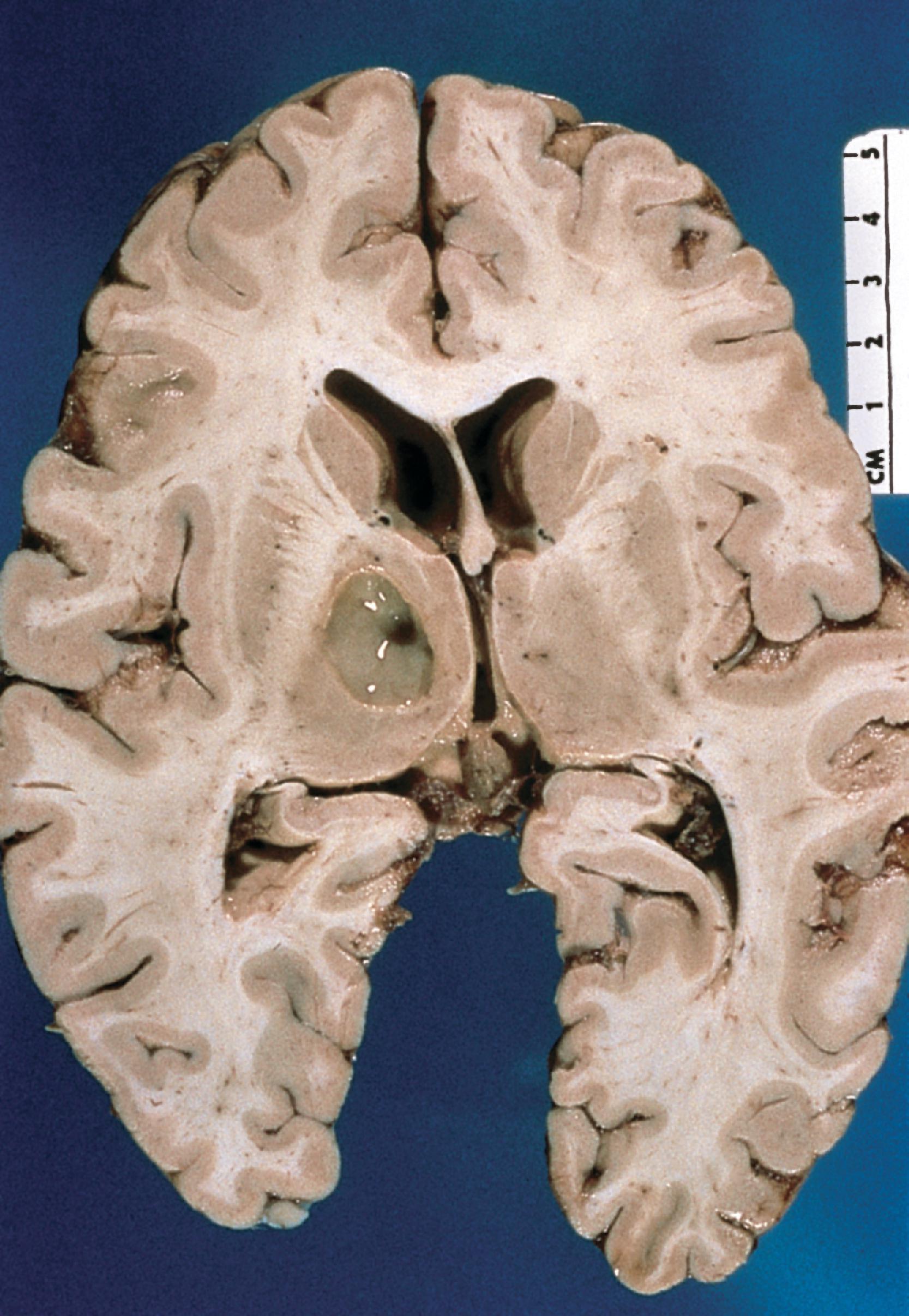
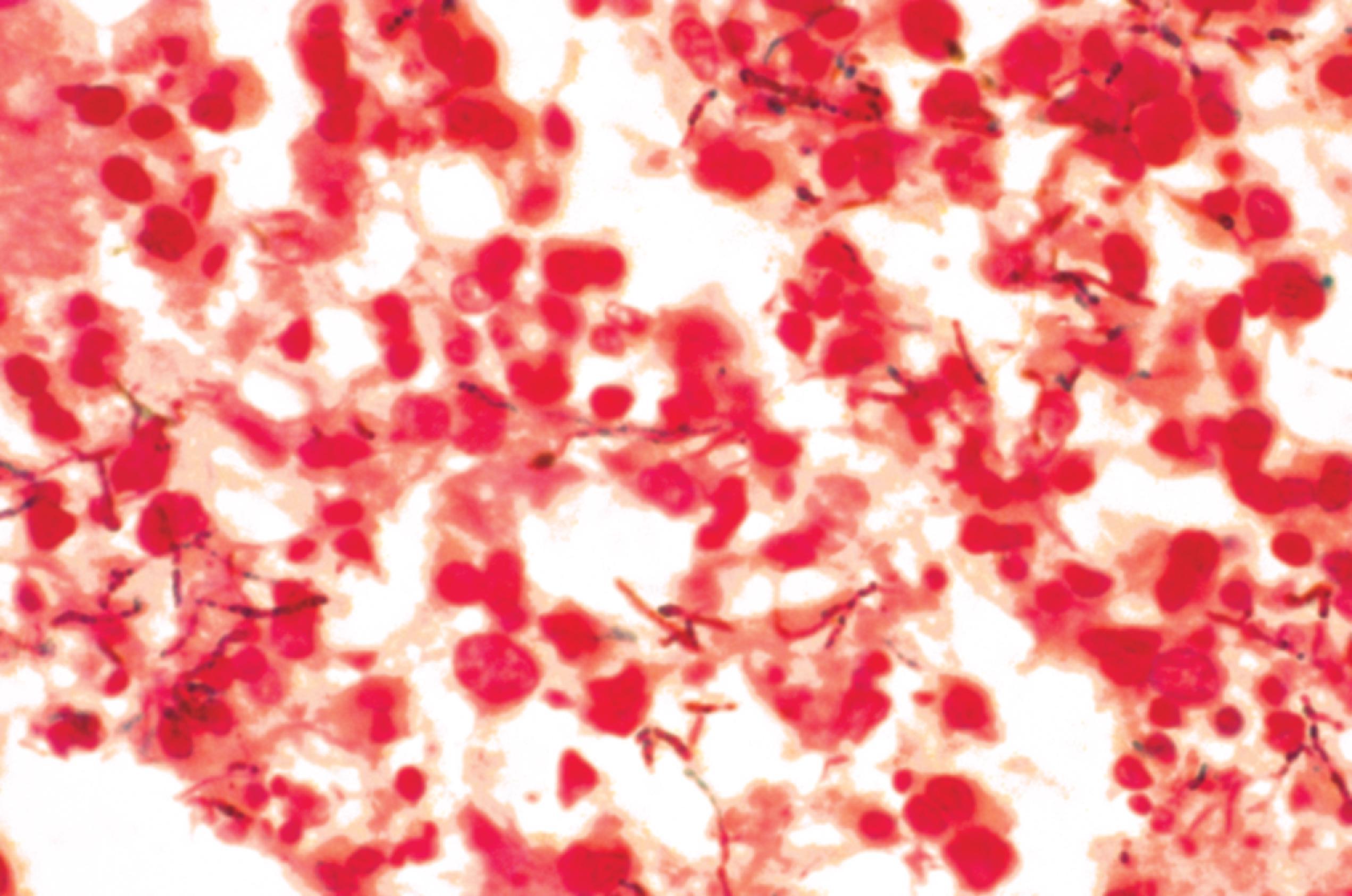
Nocardial abscesses are similar to those produced by other bacterial organisms, and a high index of suspicion is necessary to make the correct diagnosis. The organisms should be distinguished from those causing actinomycosis. The latter fail to stain with acid-fast stains.
The diagnosis of nocardiosis is often delayed, which results in suboptimal treatment in some cases. Mortality with this infection ranges from 25 % to 75 %. A variety of antibacterial agents, including the sulfonamides, are effective in the treatment of this organism.
Subdural empyema and extradural (epidural) abscesses ( Fig. 7.17 ) may develop as a result of spread from an infection in the adjacent skull bones or paranasal sinuses. When this process occurs in the spinal epidural space, there may be compression of the underlying spinal cord, which constitutes a neurosurgical emergency (and leads to a possible after-hours frozen section).
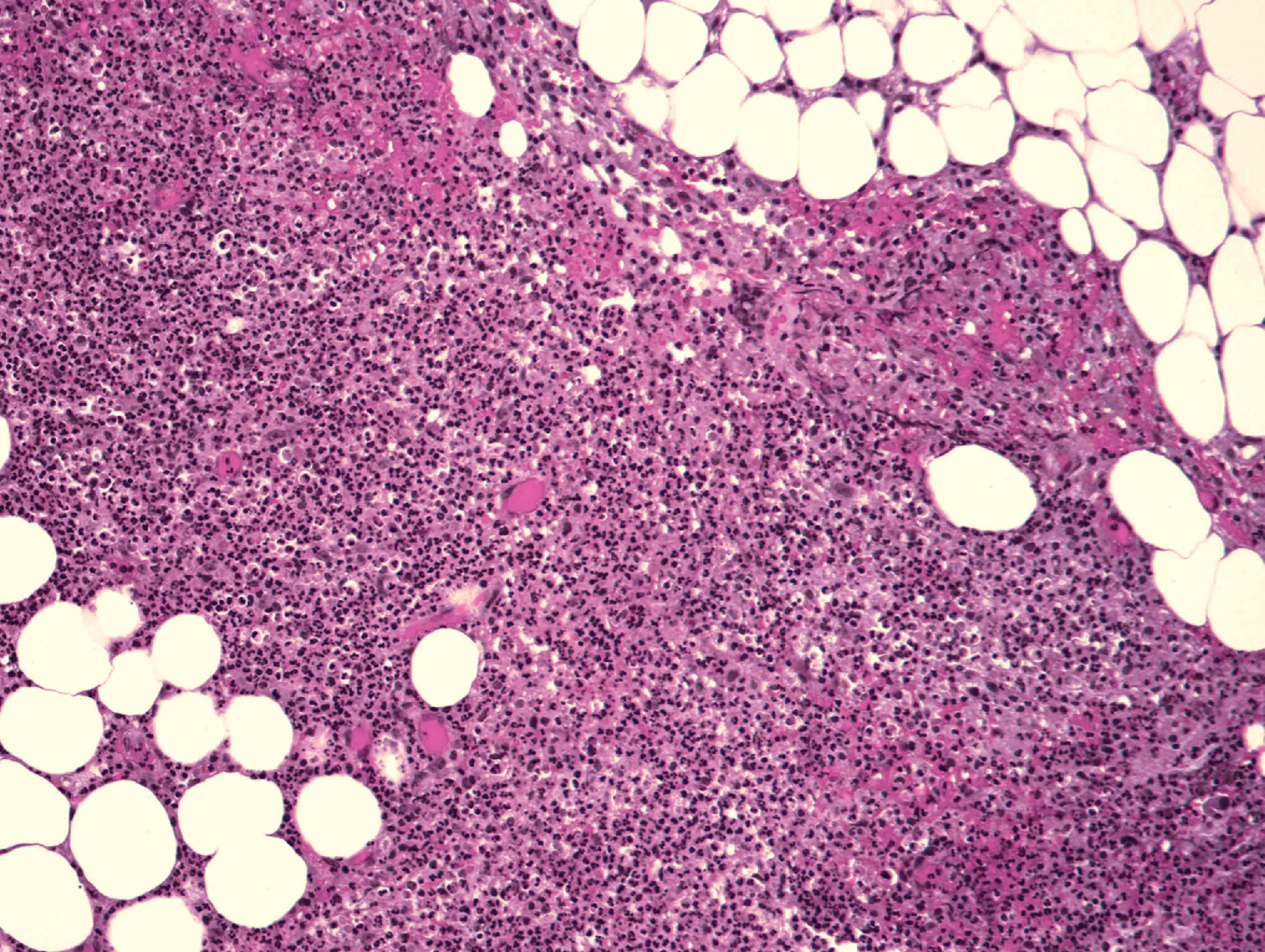
Sarcoidosis is a granulomatous, multisystem disorder of unknown etiology. It is thought to be a disorder of immune complex deposition that triggers a granulomatous response. No specific organism has been unequivocally associated with this disease. Neurosarcoidosis typically affects the base of the brain, especially the hypothalamus and optic region, and produces a variety of neurologic manifestations including cranial nerve deficits, long tract signs, autonomic dysfunction, and endocrine abnormalities. Its pathologic features are similar to those in other organ systems. Typically, one sees nonnecrotizing granulomatous inflammation ( Fig. 7.18 ).
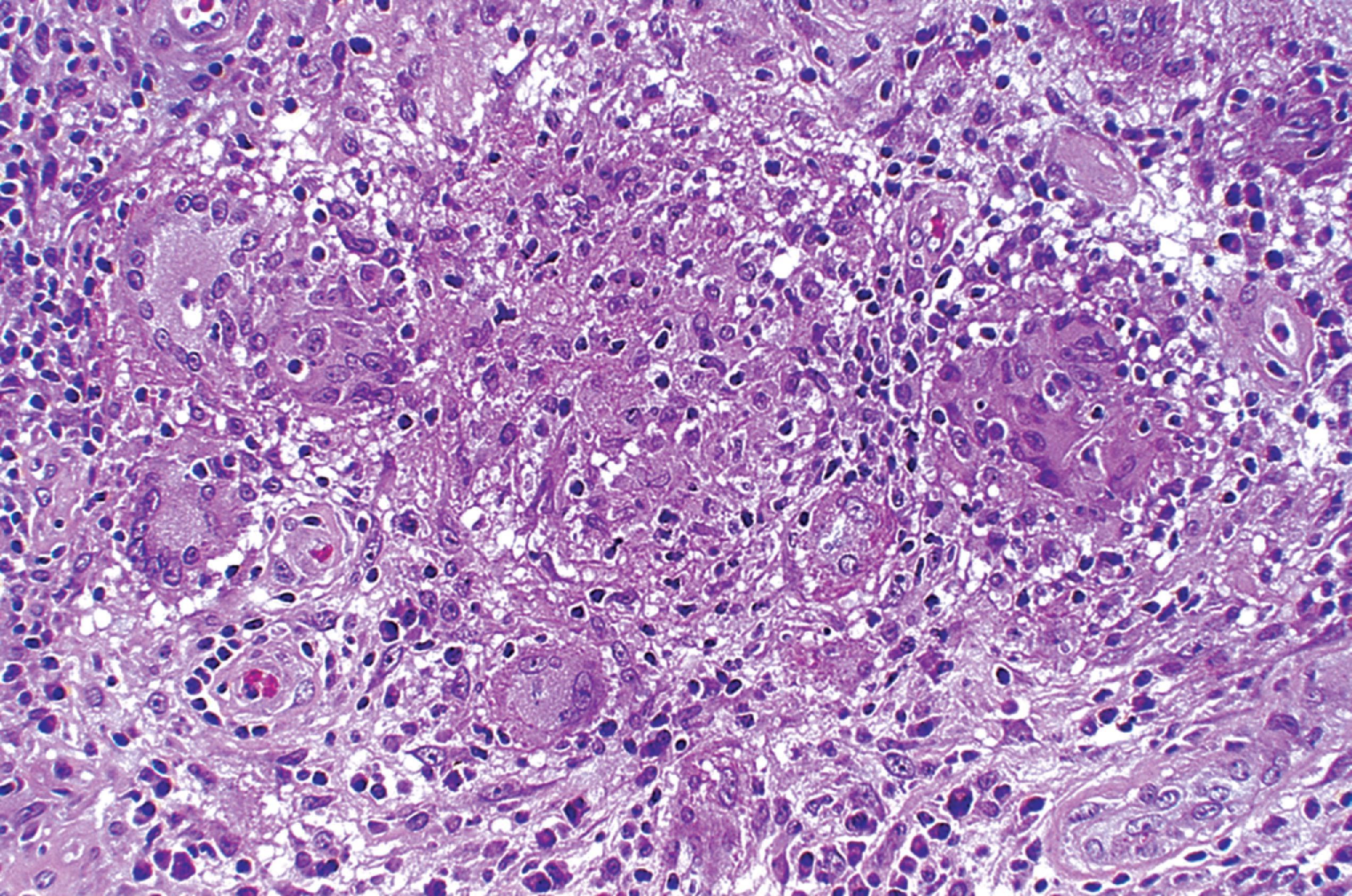
Leptospirosis is caused by the spirochete Leptospira interrogans . Clinical meningitis is frequent in this disease, and encephalitis or myelitis can occur in some cases. A form of the disease, referred to as severe icteric leptospirosis, or Weil disease, is characterized by liver and renal dysfunction, decreased level of consciousness, and widespread vasculitis with hemorrhage, including subarachnoid and intracerebral bleeding.
Brucellosis (Malta fever) is a zoonosis transmitted to humans by raw dairy products or by direct contact with animal products such as the placenta. Manifestations of neurobrucellosis include meningitis, encephalitis, myelitis, radiculoneuritis, and vascular syndromes.
Cat-scratch disease, caused by Bartonella henselae , may rarely affect the CNS. An acute encephalopathy with diffuse cerebral dysfunction is most commonly observed. Most infections resolve without treatment, and infection may be confirmed serologically.
Finally, bacteria may cause neurologic damage indirectly by the production of toxins. Bacteria producing CNS toxins include those causing diphtheria, tetanus, botulism, and shigellosis.
Fungal infections (mycoses) of the CNS are most commonly seen in immunocompromised patients. Most CNS infections occur secondarily via hematogenous dissemination from a primary focus, usually in the lung. Infection by fungal organisms may result in meningitis, parenchymal infections, or a combination of these patterns. In general, organisms that appear as yeasts in tissue cause meningitis, whereas those that form hyphae in tissue cause parenchymal lesions. In many instances the organisms can be visualized in tissue sections stained with routine hematoxylin-eosin (H&E); however, special stains such as methenamine silver and PAS are often used to highlight fungi.
Cryptococcosis is caused most commonly by Cryptococcus neoformans , an encapsulated, spherical budding yeast found in soil and wood that have been contaminated with bird excreta. C. gattii has recently emerged as an important pathogen with outbreaks in British Columbia and the Pacific Northwest of the United States associated with fir and oak trees.
Cryptococcosis occurs in all races and is more common in males. It sometimes develops spontaneously in previously healthy individuals; however, in up to 85 % of cases it is associated with debilitating illnesses. Predisposing conditions include lymphoproliferative disorders, corticosteroid therapy, organ transplantation, rheumatologic disease treated with monoclonal antibodies, and HIV infection. Patients present with headache, fever, cranial neuropathies, altered mentation, lethargy, memory loss, and signs of meningeal irritation. Restoration of pathogen-specific immunity in transplant patients or those with HIV infection can result in the immune reconstitution inflammatory syndrome (IRIS); clinical features of cryptococcal IRIS are similar to those of active cryptococcal infection. Imaging studies are often normal due to a sparse inflammatory infiltrate but may reveal diffuse meningeal enhancement as well as multiple punctuate lesions, which often involve the basal ganglia. CSF stains may demonstrate the organisms, or cryptococcal polysaccharide capsular antigen may be detected in CSF and/or blood.
An infection caused by the budding yeast C. neoformans
Occurs worldwide
More common in males
85% of patients have other debilitating conditions
Subacute or chronic meningitis
Steadily progressive course in most cases
Combination treatment with flucytosine and amphotericin B
In most cases the leptomeninges are thickened and opaque, particularly over the base of the brain and cerebellum. Hydrocephalus may be present in chronic cases. Parenchymal lesions resemble soap bubbles ( Fig. 7.19 ); this appearance is related to exuberant capsular material produced by the proliferating organisms. Lesions are most commonly seen in the basal ganglia and thalamus. Rarely, masses of fungi aggregate in an inflammatory lesion, a finding referred to as a cryptococcoma.
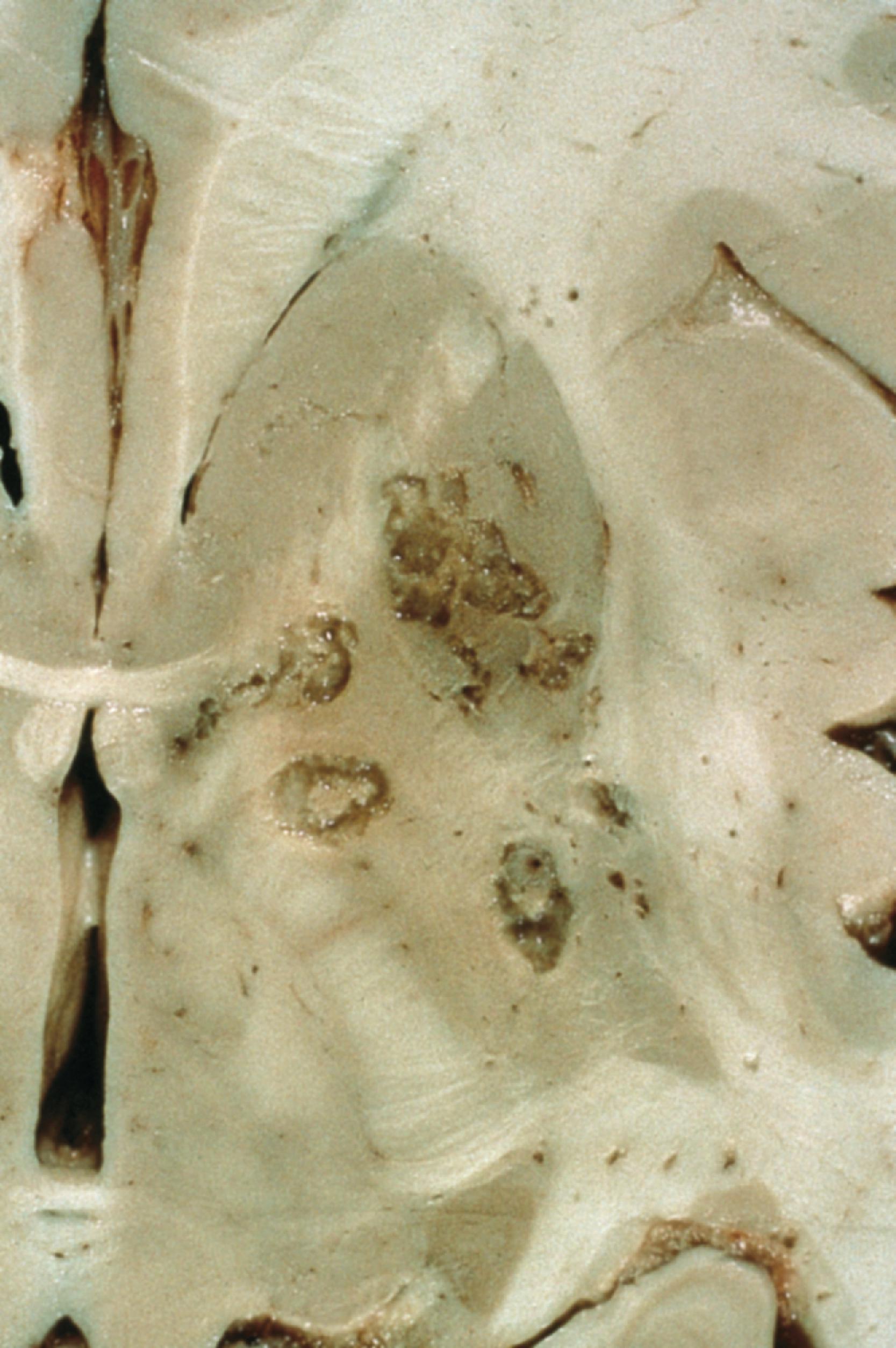
The inflammatory infiltrate in cryptococcosis is typically scant. Granulomatous inflammation may be seen in some cases. The organisms may form small colonies, usually around blood vessels. They stain faintly with H&E but can be highlighted with PAS, mucicarmine, Alcian blue, or methenamine silver stains ( Fig. 7.20 ). Small buds may be attached to the main body by a short neck.
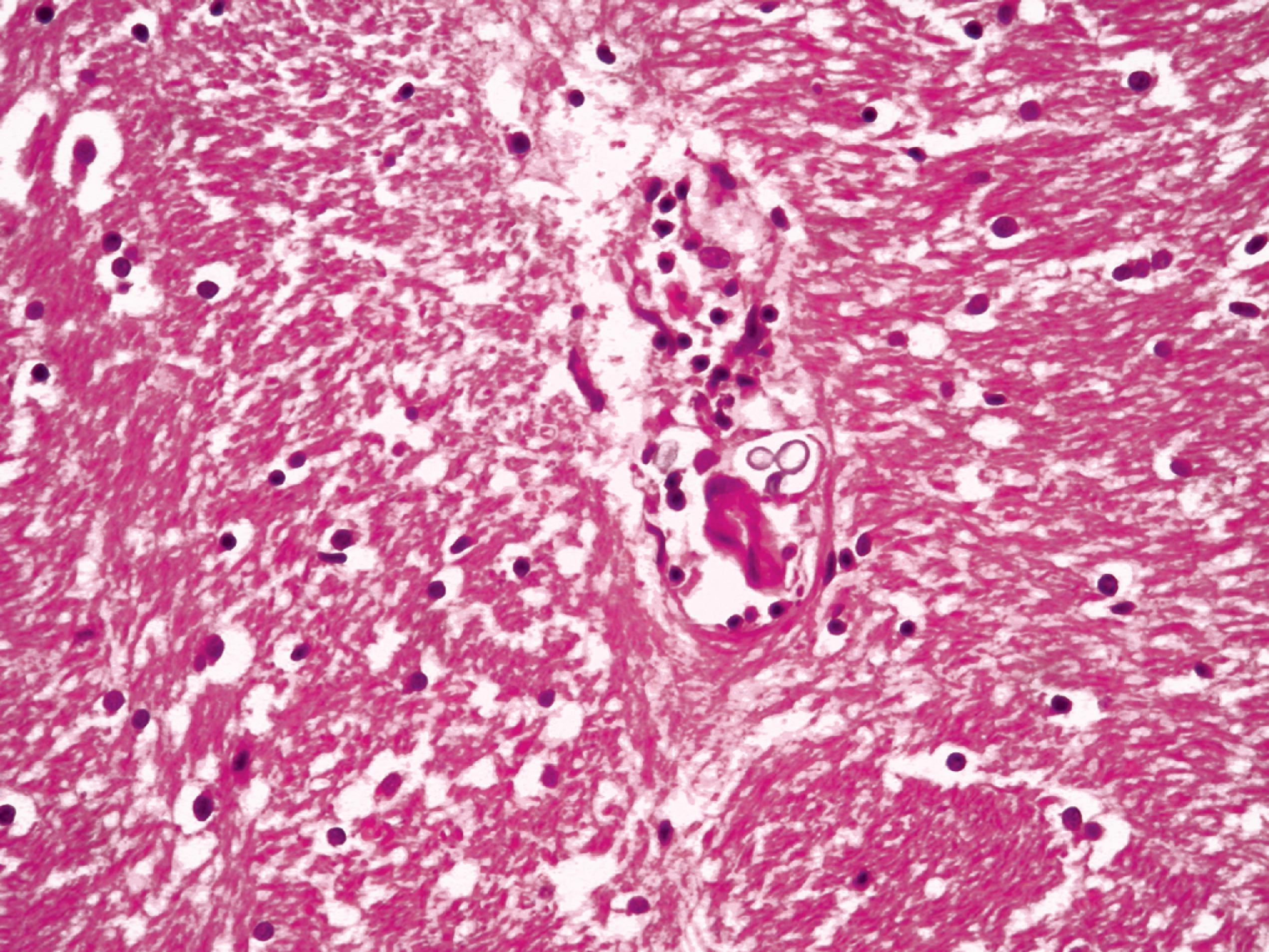
The yeast forms of C. neoformans must be distinguished from those of Blastomyces dermatitidis , which are slightly larger and exhibit broad-based budding. These organisms may also be confused with corpora amylacea, which exhibit a similar staining pattern.
Cryptococcosis typically runs a steadily progressive course ranging from a few weeks to 6 months. Periods of relapse and remission are common in untreated individuals. Flucytosine in combination with amphotericin B deoxycholate is currently the first-line treatment of severe cryptococcal disease. In HIV-associated infections, anti-retroviral therapy (ART) has a major impact on long-term prognosis; however, there may be an increased risk of IRIS among HIV-infected patients initiated on ART early after the diagnosis of an opportunistic infection.
Members of the genus Candida are the most commonly identified opportunistic fungi in humans. In immunocompetent individuals, they may be part of the normal flora of the oral cavity, gastrointestinal tract, and urogenital tract. In situations where natural defense mechanisms are compromised, Candida spp. may over-proliferate, leading to the development of invasive candidiasis. Candida albicans is the most common organism in both immunocompromised and immunocompetent patients, but its prevalence has begun to decrease over the past decade, while the frequency of non– C. albicans species has gradually increased.
Involvement of the CNS is mainly observed in patients who develop disseminated candidiasis. Hematogenous dissemination is promoted by a variety of conditions including neutropenia, diabetes, and AIDS; it is also seen in patients with extensive wounds (burns and operations) as well as premature infants, those recovering from transplantation, or in patients who have undergone catheterization. Meningoencephalitis is the most common clinical manifestation of neurocandidiasis; other clinical presentations include endophthalmitis, multiple cerebral abscesses, vasculitis, intraventricular fungus balls, hydrocephalus, calcifications, and cranial neuropathies.
The brain is often grossly normal. Microabscesses may be present and are most commonly seen in the distribution of the anterior and middle cerebral arteries.
Histologically, candidiasis is characterized by small foci of cerebritis ( Fig. 7.21 ). Granulomatous inflammation may be seen in some cases. Both yeast forms and pseudohyphae may be present and are faintly basophilic in H&E-stained sections. The organisms stain intensely with both PAS and methenamine silver ( Fig. 7.22 ). Vascular complications, including infarcts, mycotic aneurysms, and subarachnoid hemorrhage, occur in a significant number of patients.
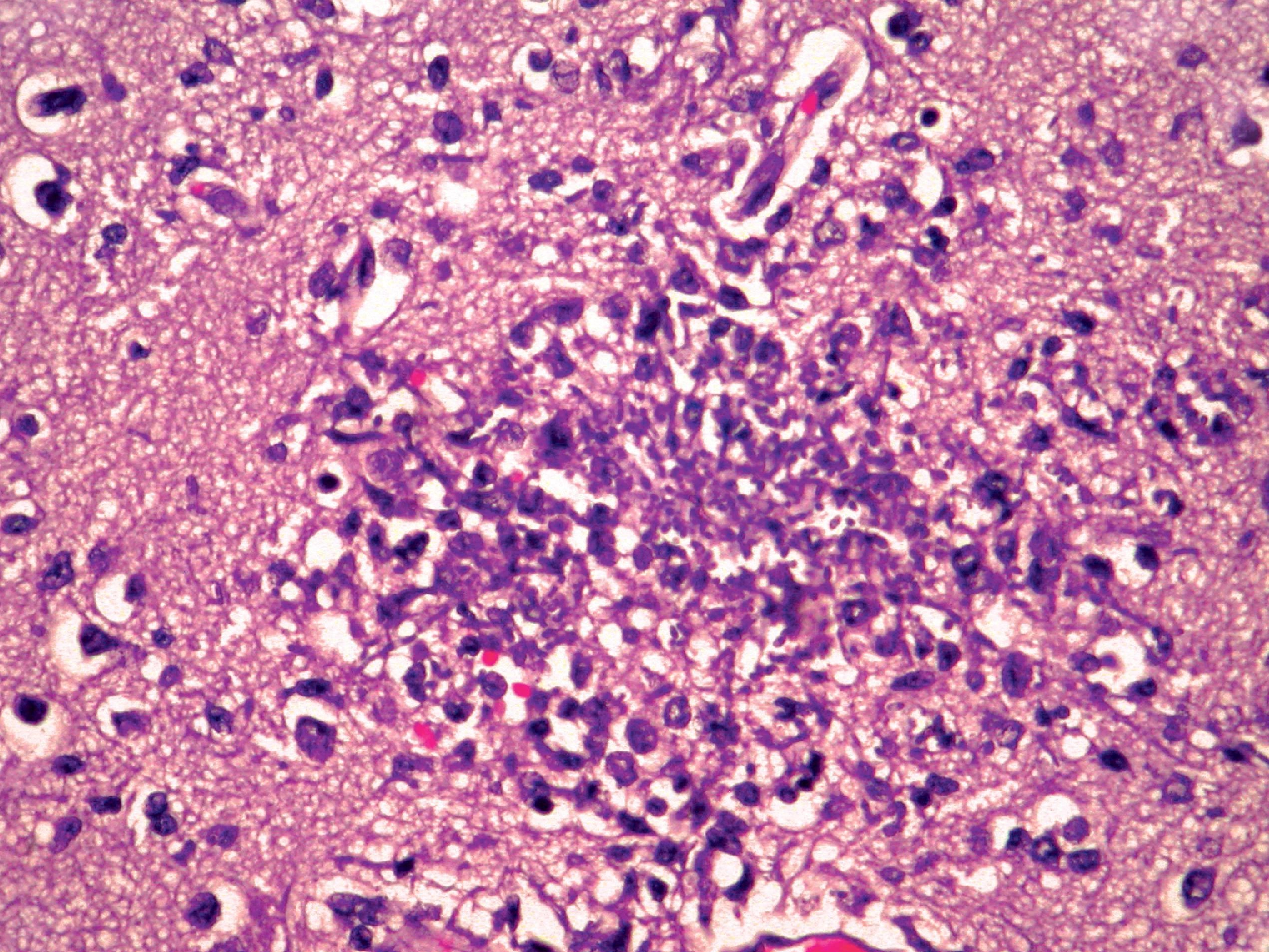
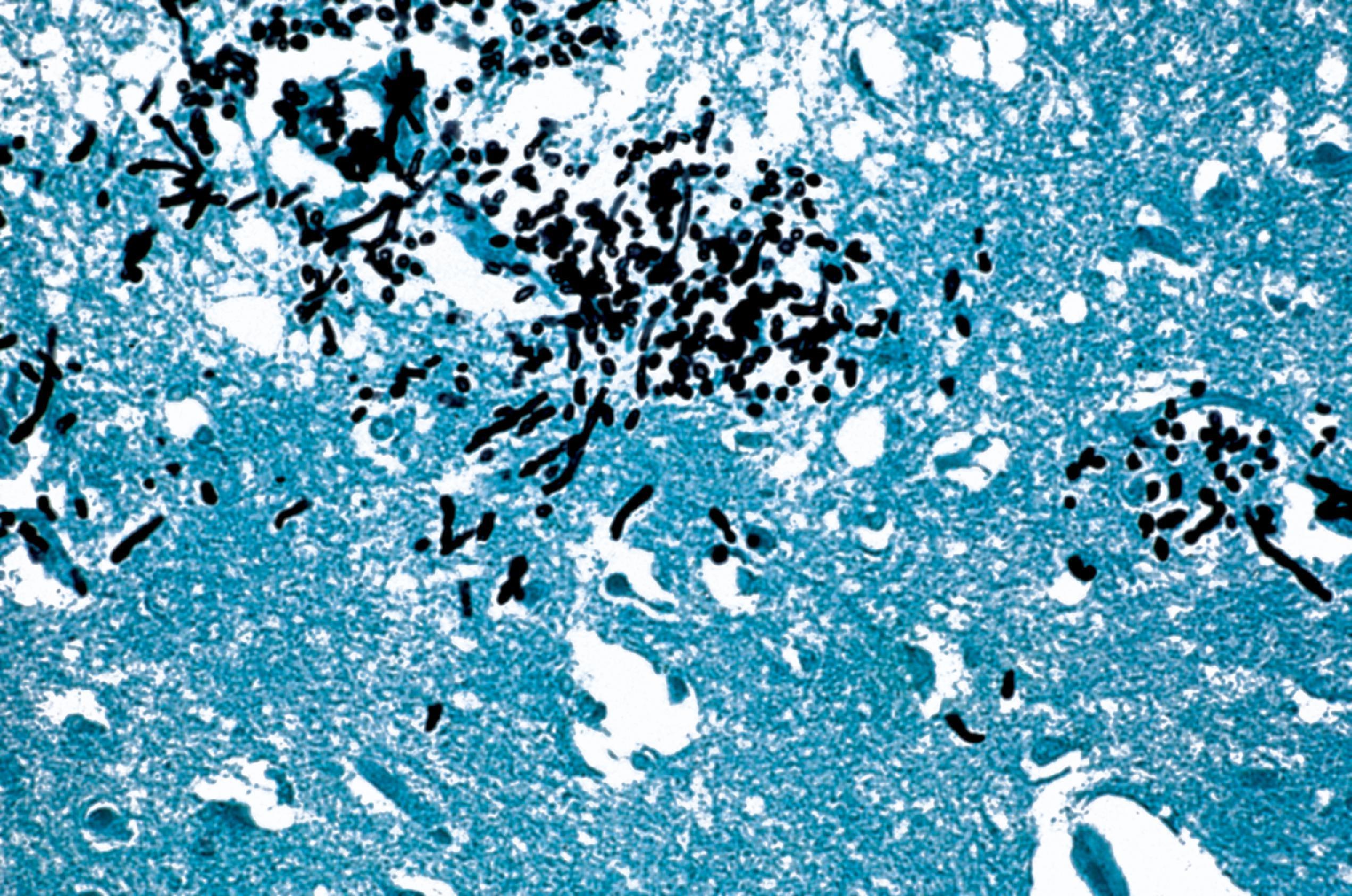
Candida species may be confused with both other yeasts and hyphal organisms. The pseudohyphae are constricted at the point of septation and therefore differ from true hyphae.
Mortality ranges up to 90% in patients with CNS involvement. Treatment of CNS candidiasis is with amphotericin B and 5-fluorocytosine.
Aspergillosis is caused by several different fungal species, but most cases are due to Aspergillus fumigatus or A. flavus . These organisms are found in soil, plants, and decaying matter. CNS infection occurs via hematogenous dissemination; the usual portal of entry is the respiratory tract. Some cases are the result of direct extension from the paranasal sinuses or from head trauma.
CNS aspergillosis typically occurs in the setting of corticosteroid therapy and in neutropenic patients, particularly those with hematologic malignancies. It can also occur in immunocompetent patients and those with milder forms of immunosuppression, such as diabetes mellitus. Focal neurologic deficits are common. Other frequently encountered signs and symptoms include fever, headache, and seizures. Clinical features are usually dramatic and tend to progress rapidly. Imaging studies are nonspecific. Galactomannan and 1,3-β-d-glucan may be found in the serum or CSF. PCR performed on CSF and serum may provide a diagnosis in some cases.
Multiple lesions are usually present and most often involve areas supplied by the anterior and middle cerebral arteries. Because the fungus is highly angiotropic, foci of hemorrhagic necrosis are common ( Fig. 7.23 ).
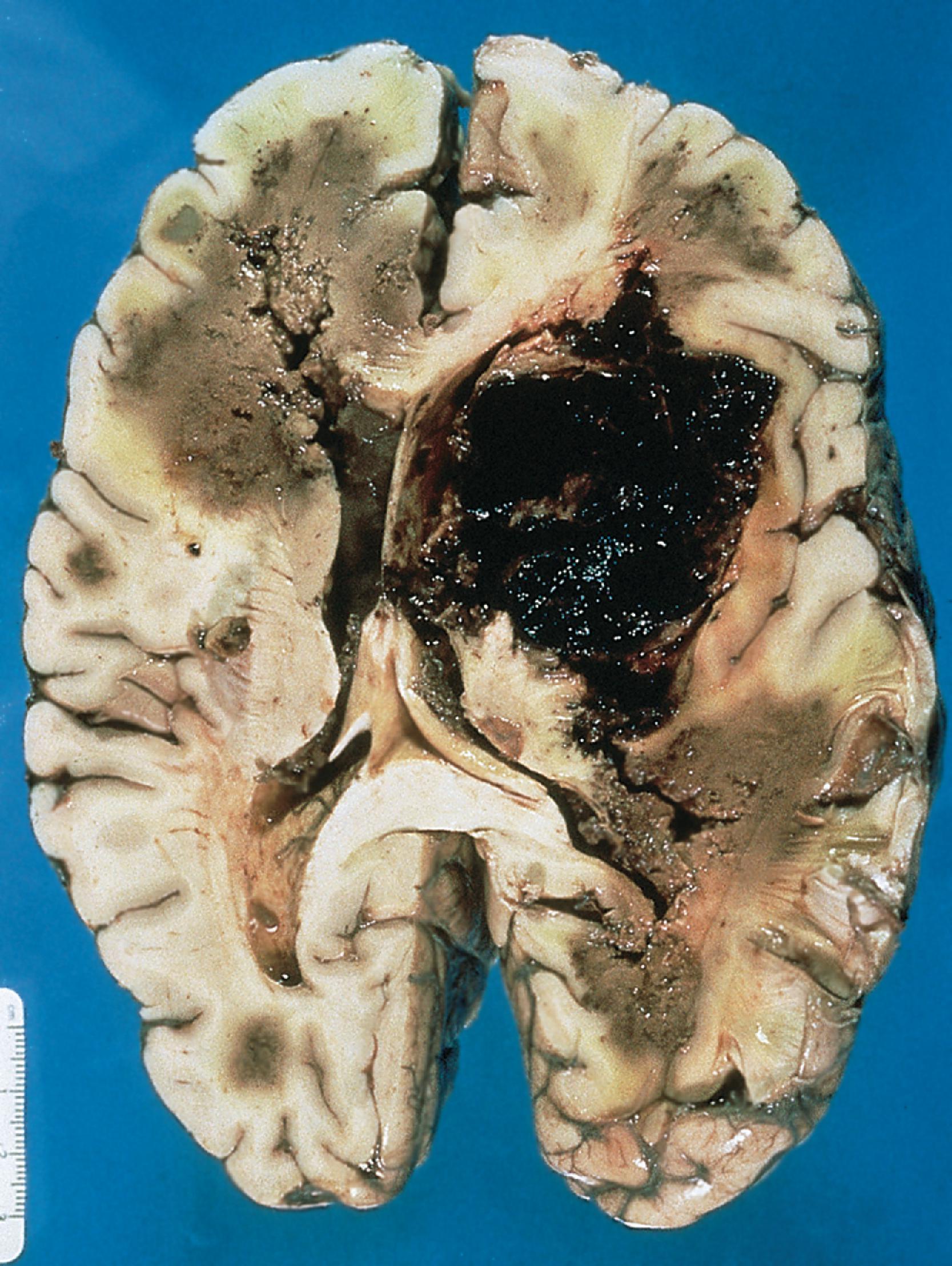
The inflammatory response depends in part on the immune status of the patient, and both neutrophilic and granulomatous inflammatory infiltrates may be seen. Blood vessels are typically involved and show thrombosis and invasion of their walls by fungi. The organisms are septate hyphae that branch at acute angles ( Fig. 7.24 ). Fruiting bodies ( Fig. 7.25 ), which are typically only seen in cultures, may rarely be seen in tissue sections if the organisms have been exposed to air.
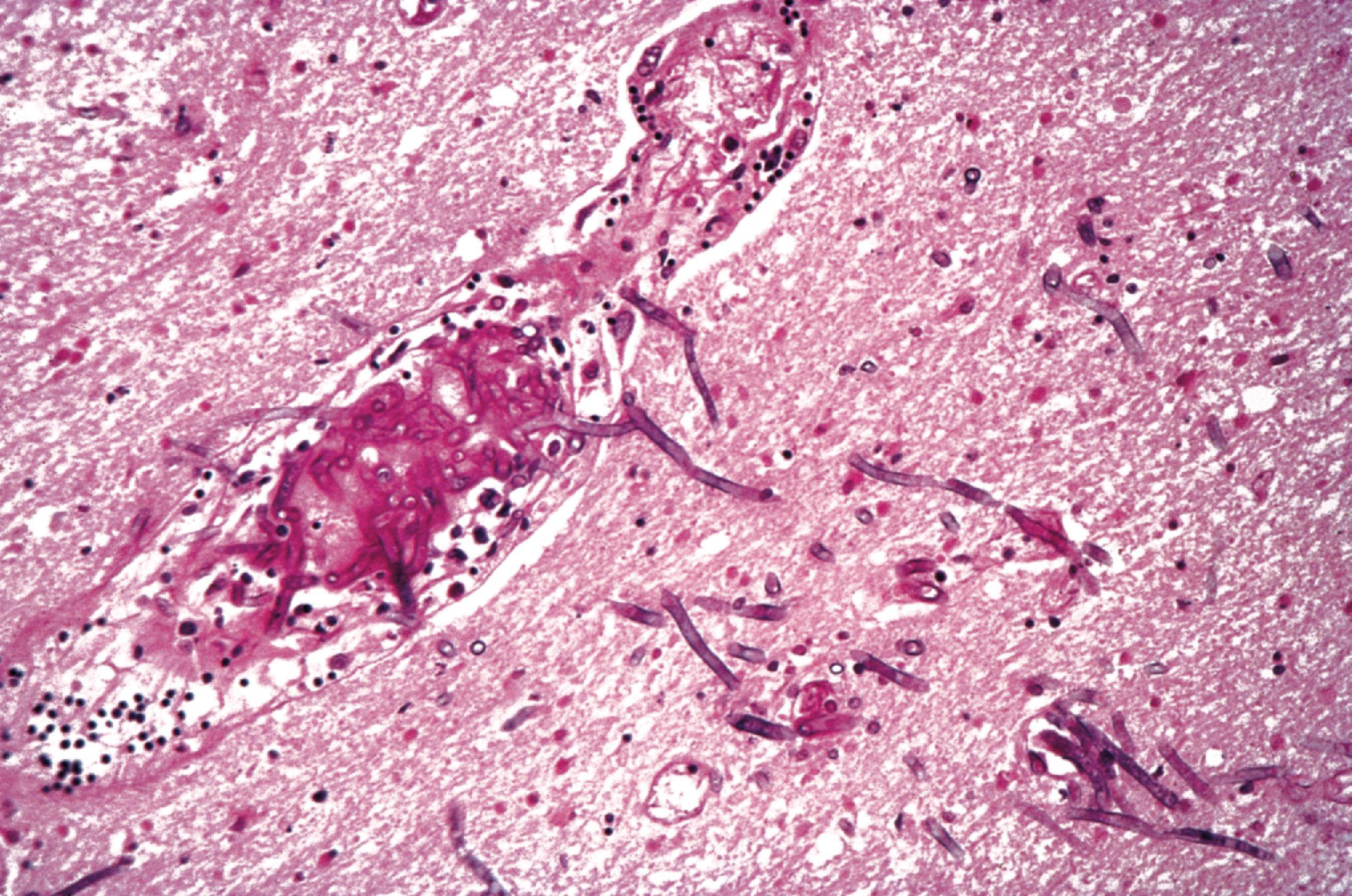
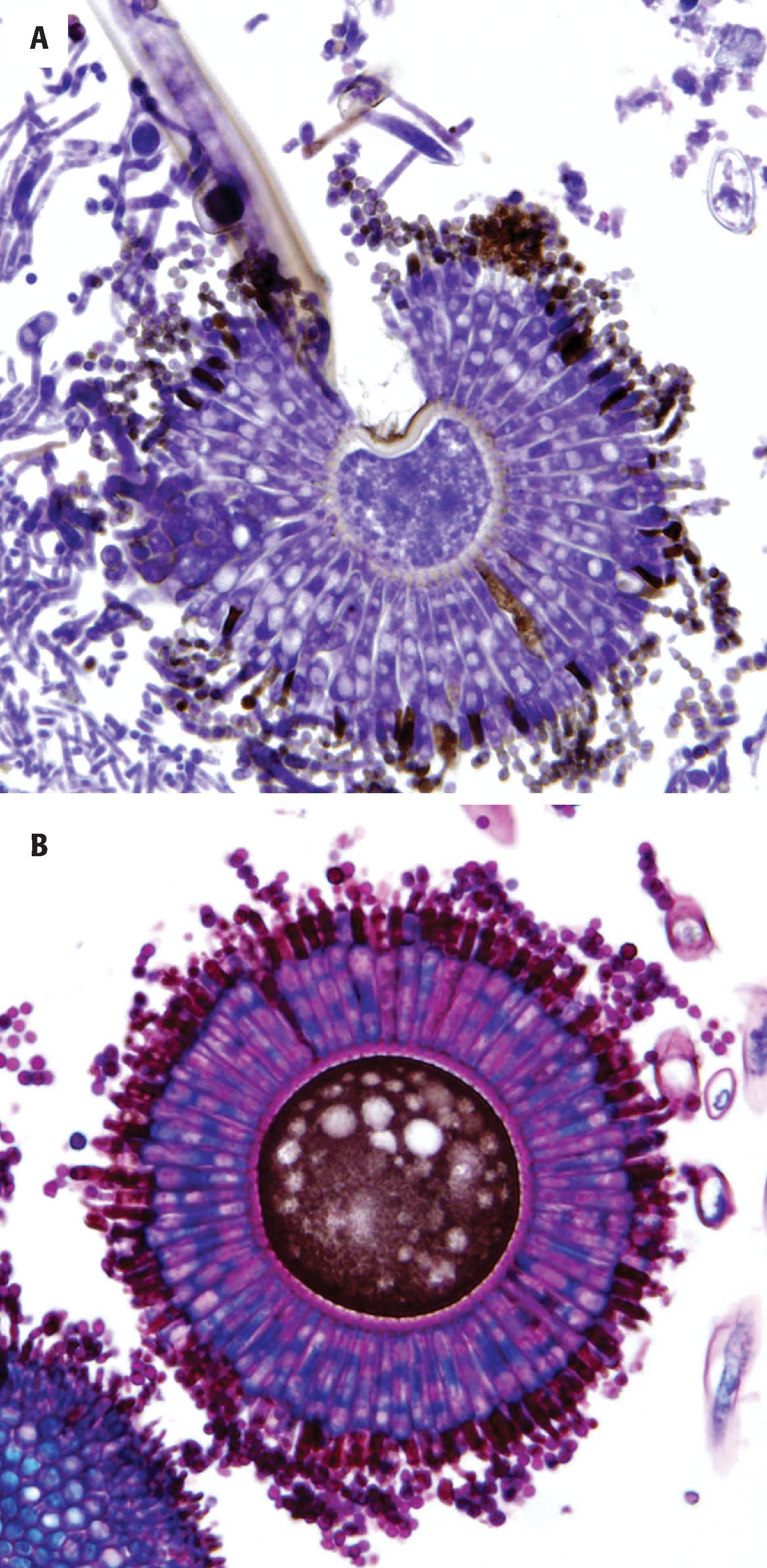
Multiple lesions
Foci of hemorrhagic necrosis
Neutrophilic and/or granulomatous inflammation
Vascular invasion and thrombosis
Septate hyphae that branch at acute angles
Mucormycosis
Other mycoses caused by septate hyphal organisms
Large, myelinated axons or cortical blood vessels
These organisms must be distinguished from the Zygomycetes (see the next section), which are typically more irregular and broader. Large, myelinated axons in swollen brain tissue and delicate, branching cerebral cortical blood vessels can also be confused with these organisms. Because of the similarity of Aspergillus species to other hyphal organisms one cannot make a definitive diagnosis of aspergillosis by histopathology alone; culture of the organisms is required to confirm the diagnosis. A diagnosis of “fungal organisms consistent with aspergillosis” is appropriate in most cases.
CNS involvement is associated with a high mortality rate, particularly in immunosuppressed patients. Treatment with voriconazole improves patient survival. Combined medical and neurosurgical treatment should be considered in these patients.
Mucormycosis, also known as zygomycosis, is caused by members of Zygomycetes, most commonly Mucor and Rhizopus spp. These organisms are ubiquitous and are found in soil, manure, and decaying vegetation. Unlike most other fungal infections involving the CNS, CNS mucormycosis (rhinocerebral mucormycosis) results from direct venous invasion through the orbital plate from a primary site of infection on the skin of the face or in the mucosa of the nose and nasopharynx. Hematogenous dissemination may also occur.
An infection caused by Zygomycetes
The rhinocerebral form occurs in the setting of diabetic ketoacidosis
Hematogenous dissemination to the CNS occurs in intravenous drug users and immunocompromised patients
Symptoms often result from involvement of the orbit
Fulminating course with death in a few days
Treated with surgery plus antifungal agents
Rhinocerebral mucormycosis is classically seen in the setting of diabetic ketoacidosis. Signs and symptoms often result from involvement of the orbit and include unilateral ophthalmoplegia, proptosis, edema of the eyelid, corneal edema, and blindness. Hematogenous dissemination to the CNS occurs in patients who are intravenous drug abusers and those who are immunosuppressed. Iron overload is also a known risk factor.
Rhinocerebral mucormycosis is characterized grossly by necrotic, hemorrhagic lesions that most commonly involve the base of the frontal lobes. When CNS involvement results from hematogenous dissemination, hemorrhagic lesions are often present in the deep gray nuclei ( Fig. 7.26 ).
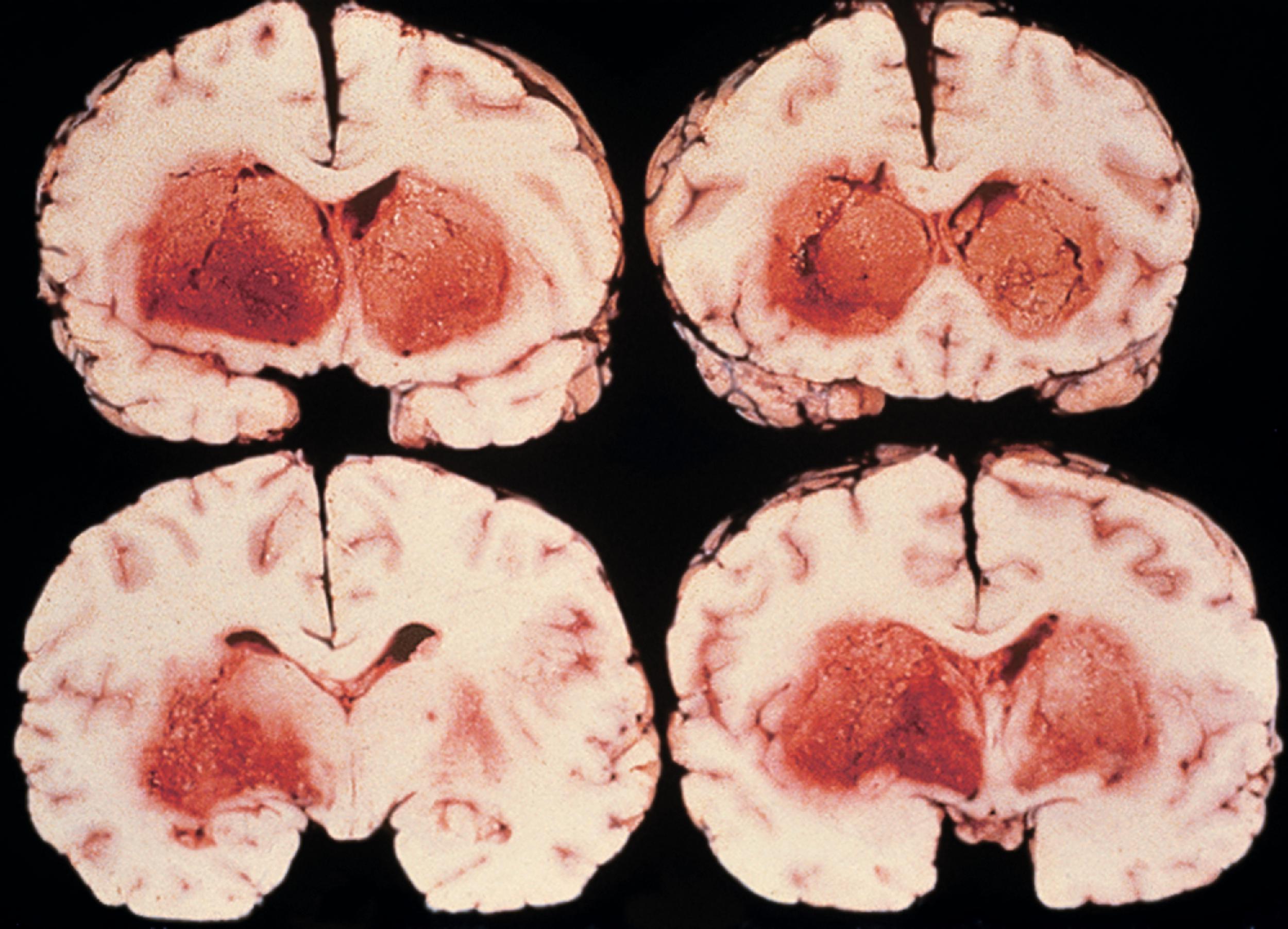
Zygomycetes organisms typically elicit a minimal inflammatory response that is predominantly neutrophilic. These fungi, like Aspergillus species, are highly angiotropic and are often identified within the walls of blood vessels. They appear as broad, nonseptate, irregular (ribbon-like) hyphae that branch at right angles ( Fig. 7.27 ).
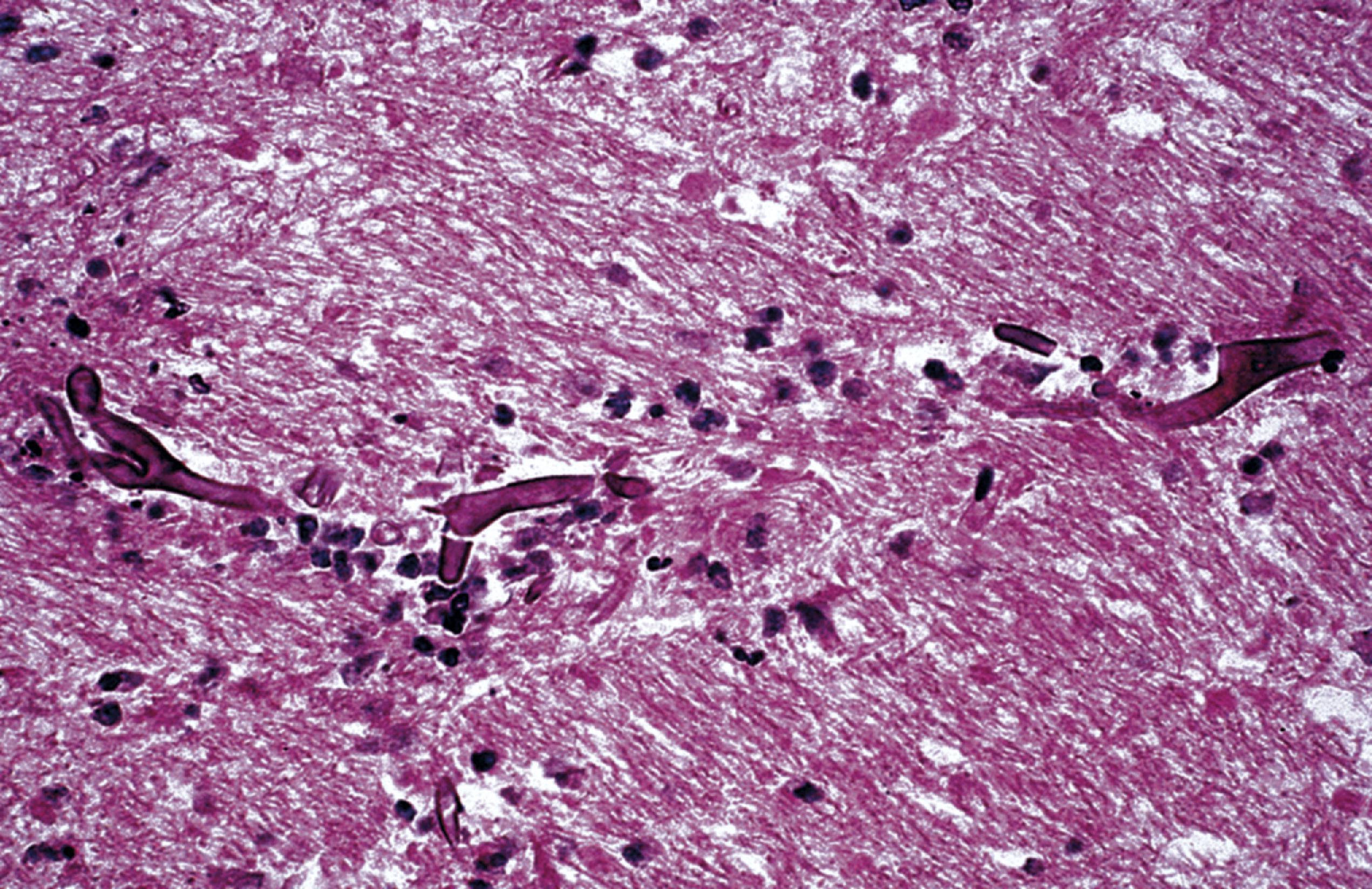
Aspergillus species, particularly when treated, can resemble Zygomycetes. Special stains (PAS and methenamine silver) are useful in demonstrating septations in the former.
Become a Clinical Tree membership for Full access and enjoy Unlimited articles
If you are a member. Log in here